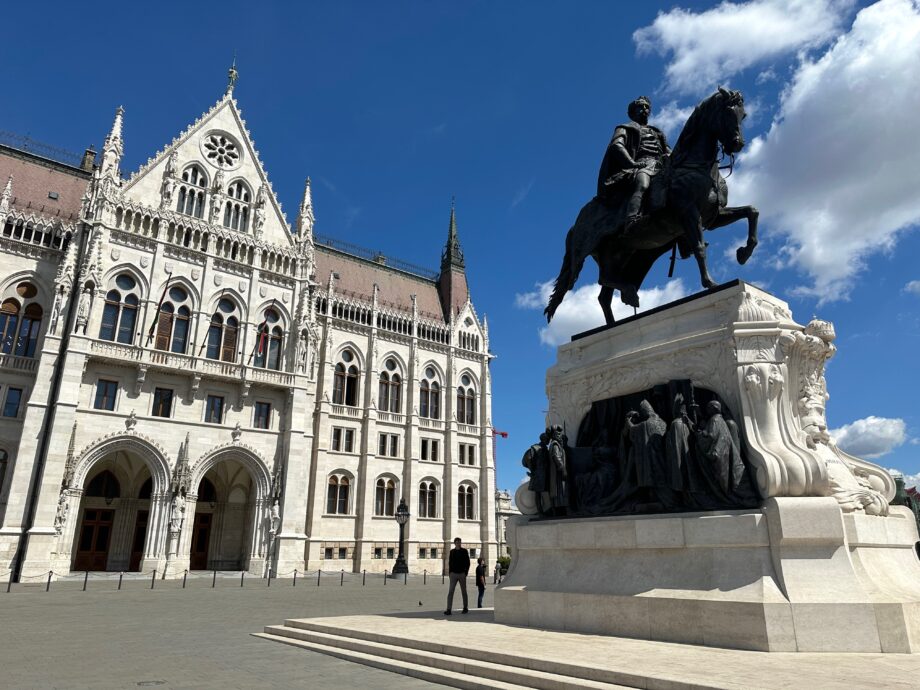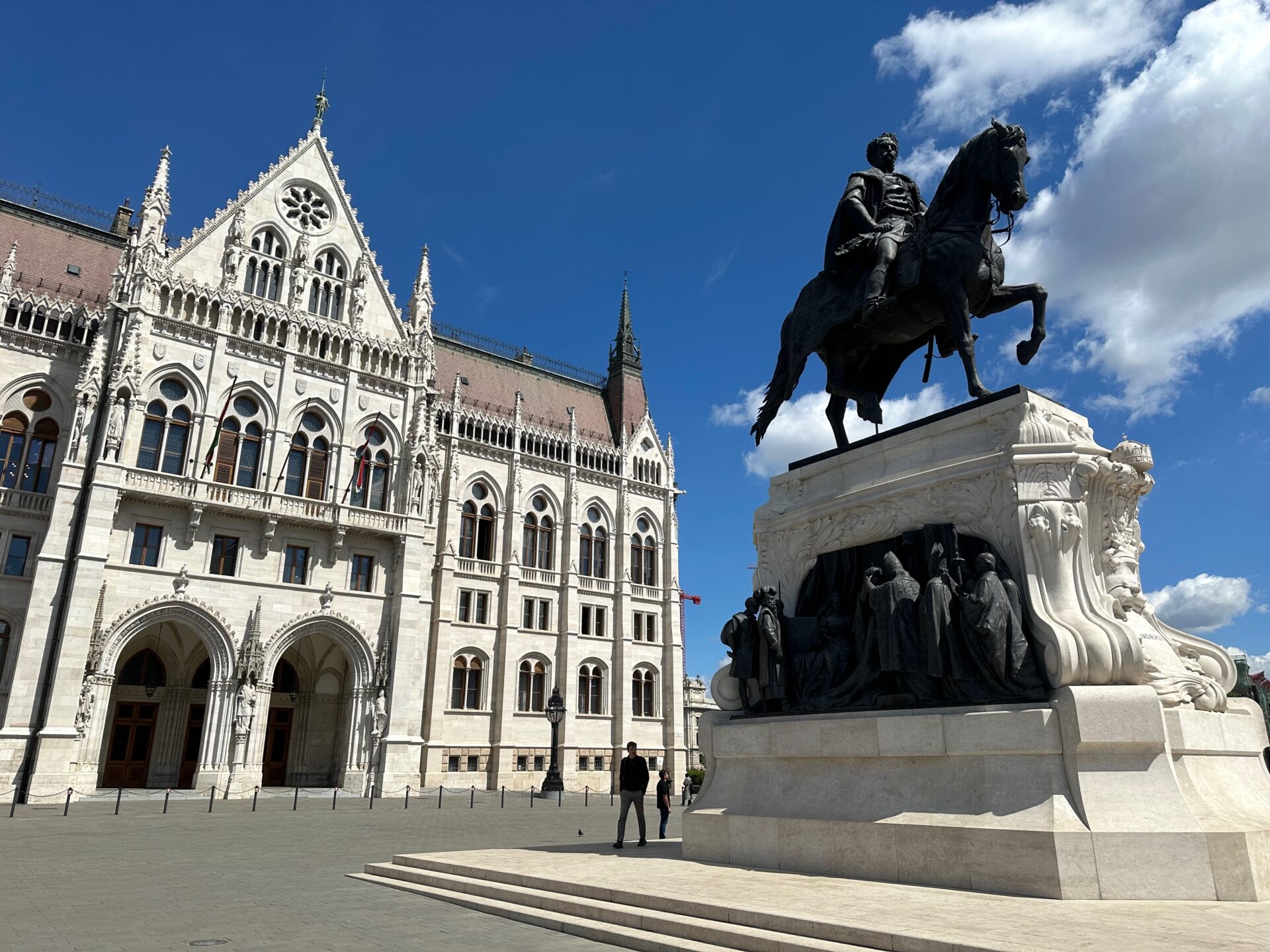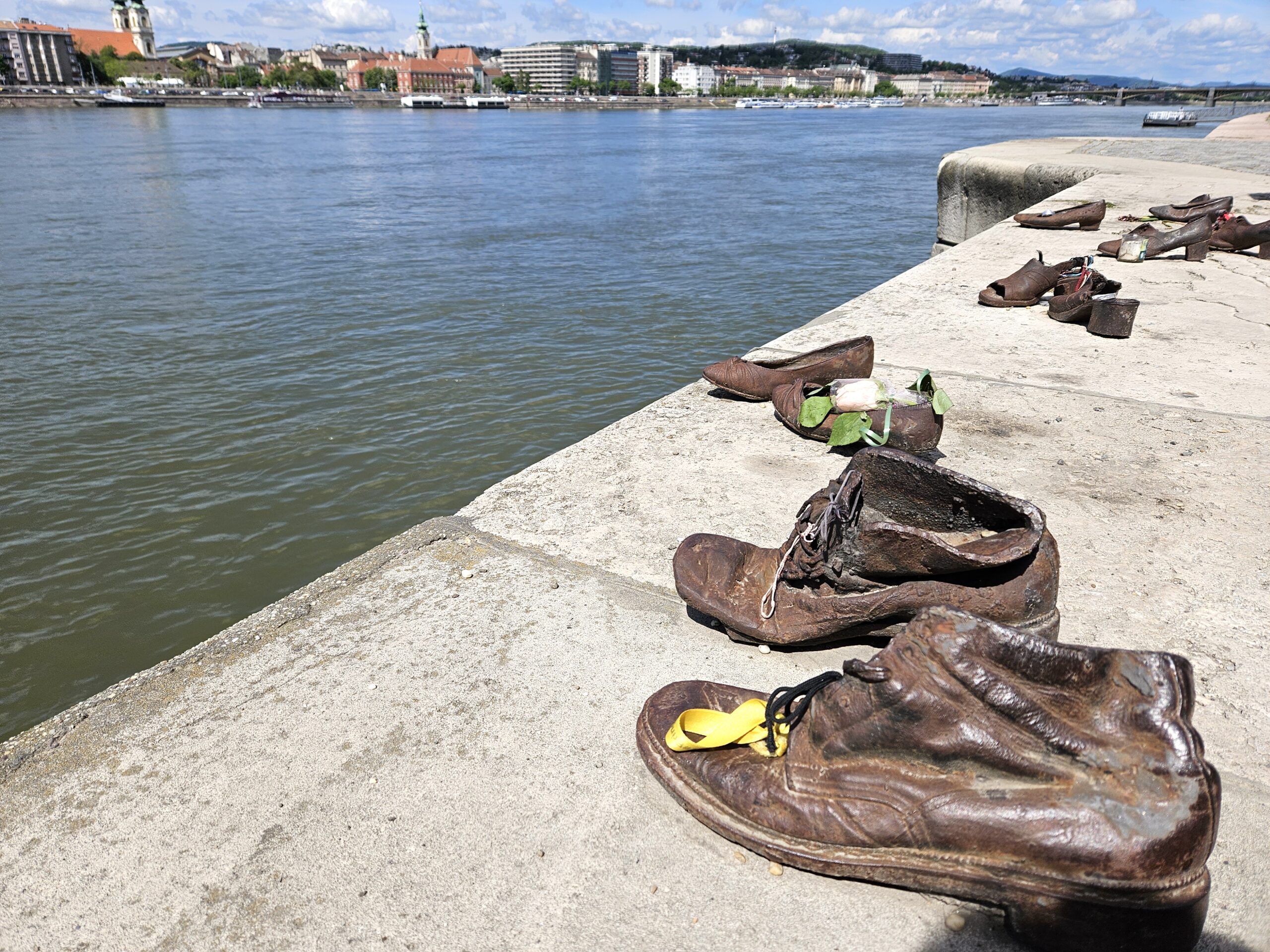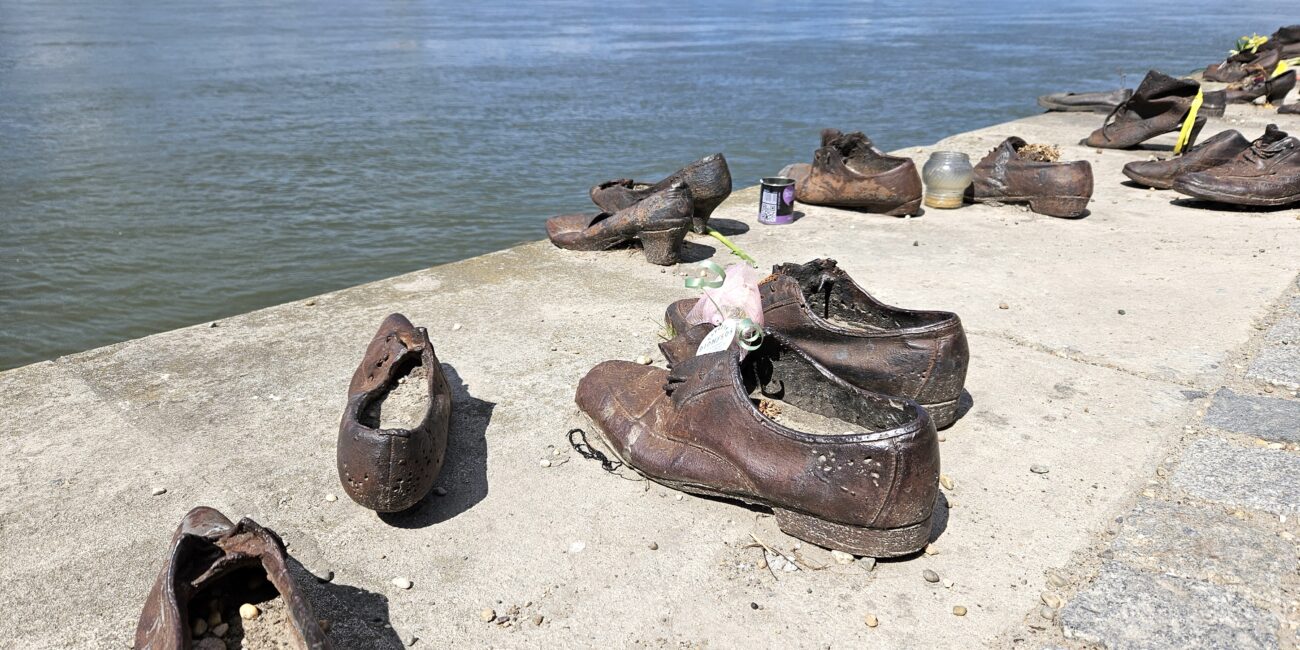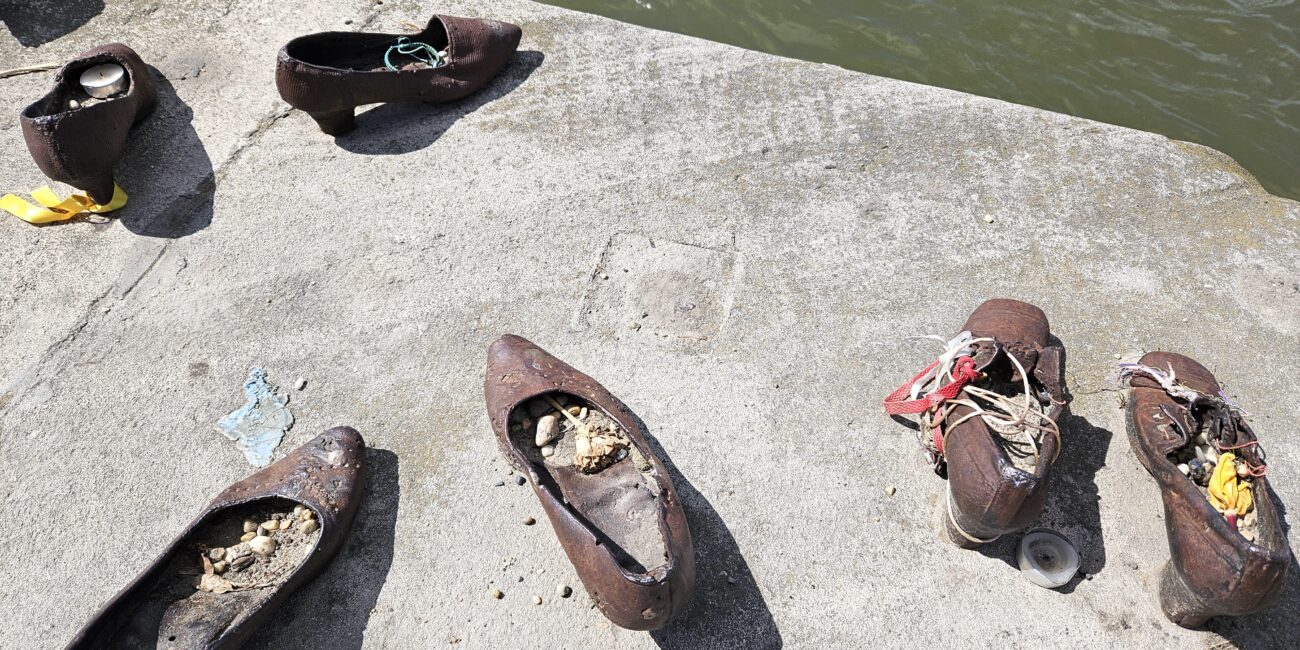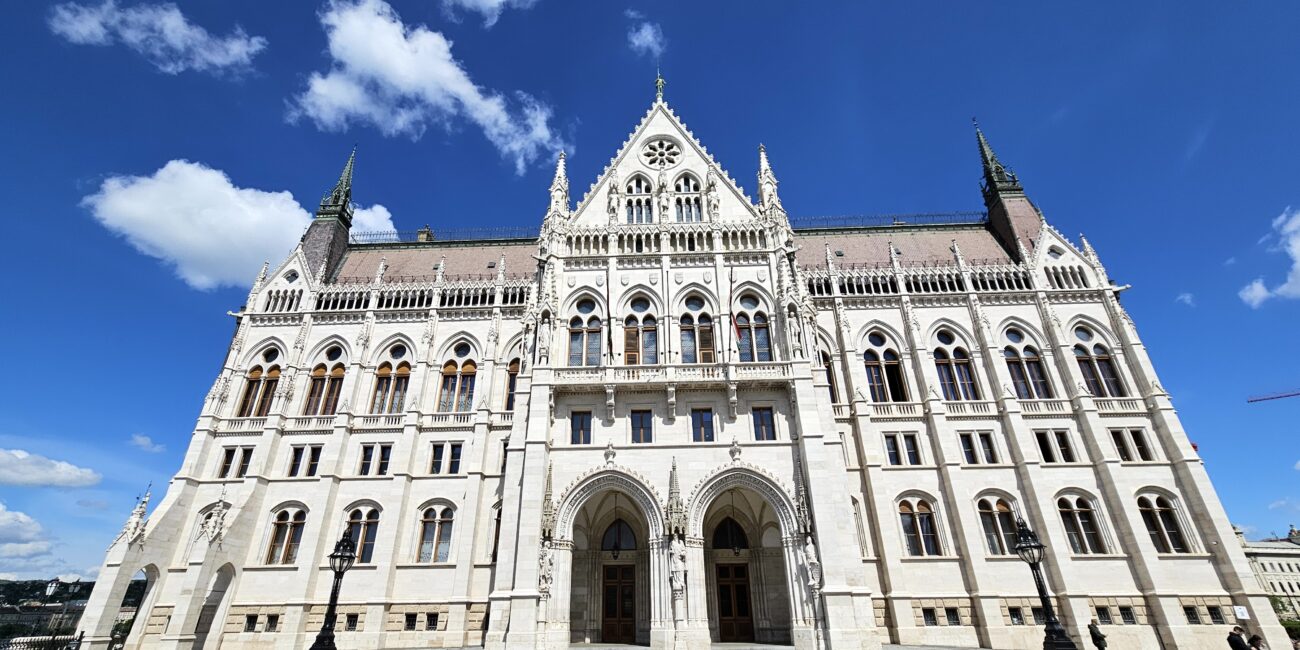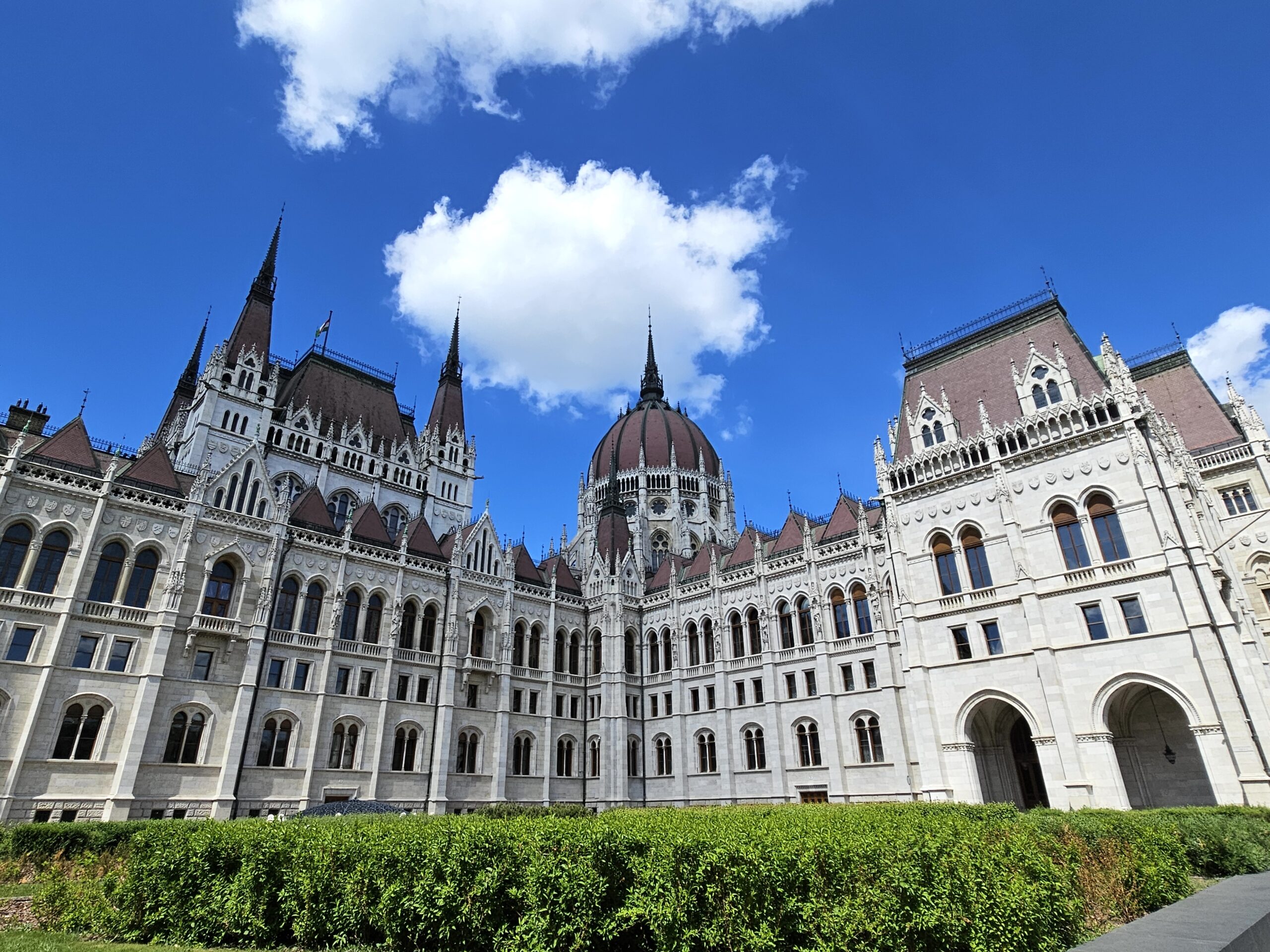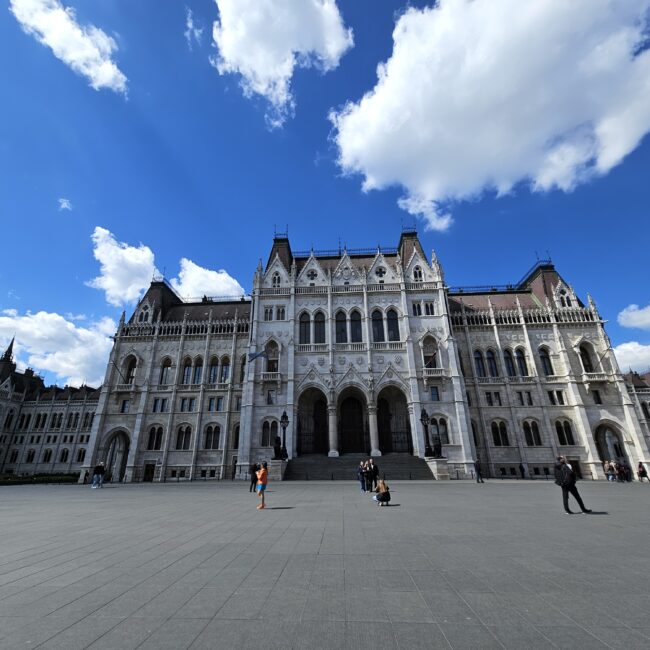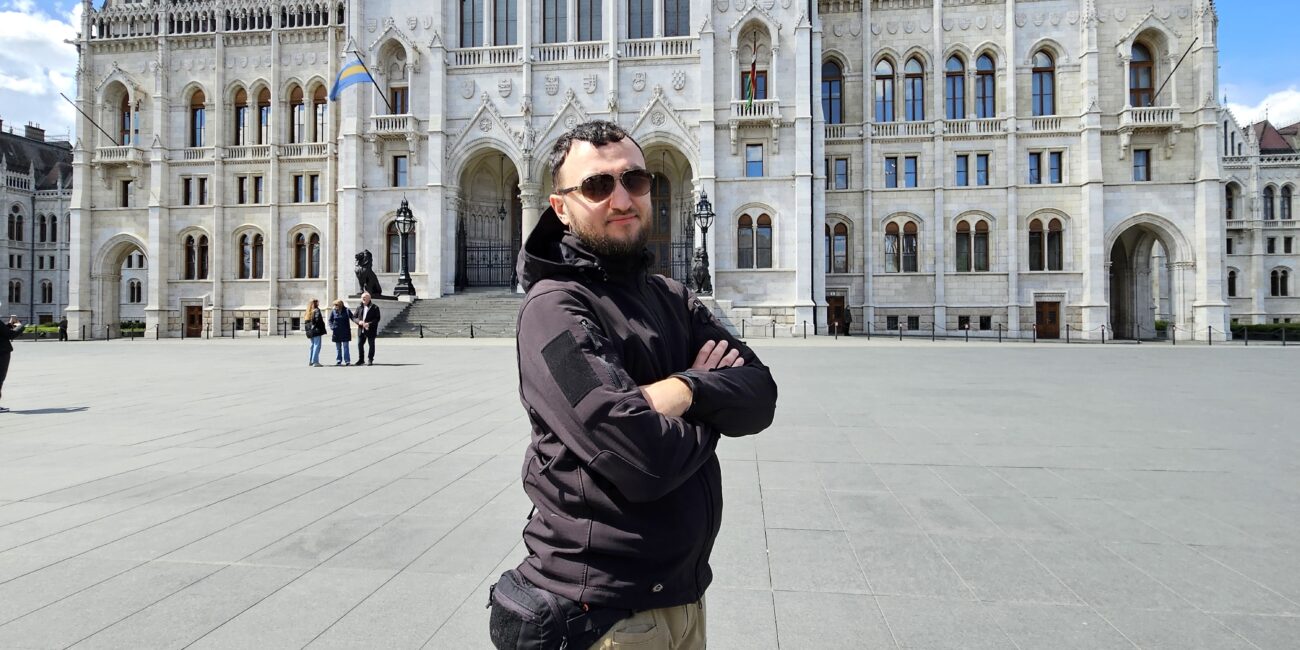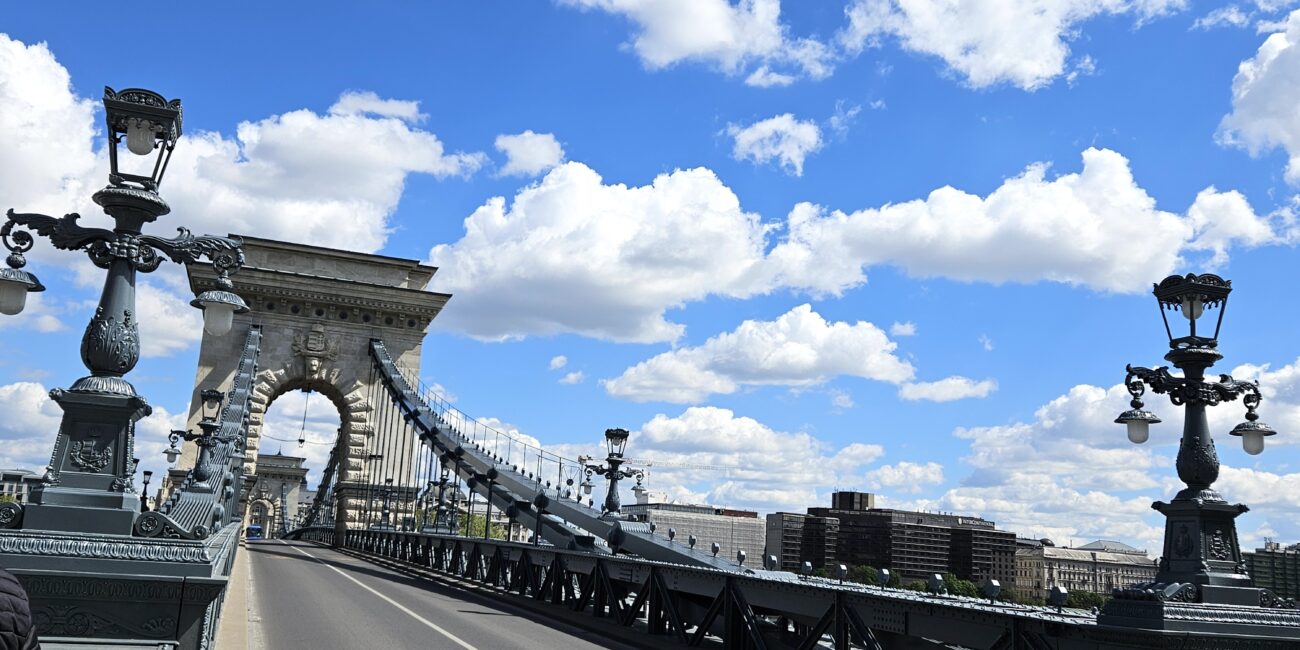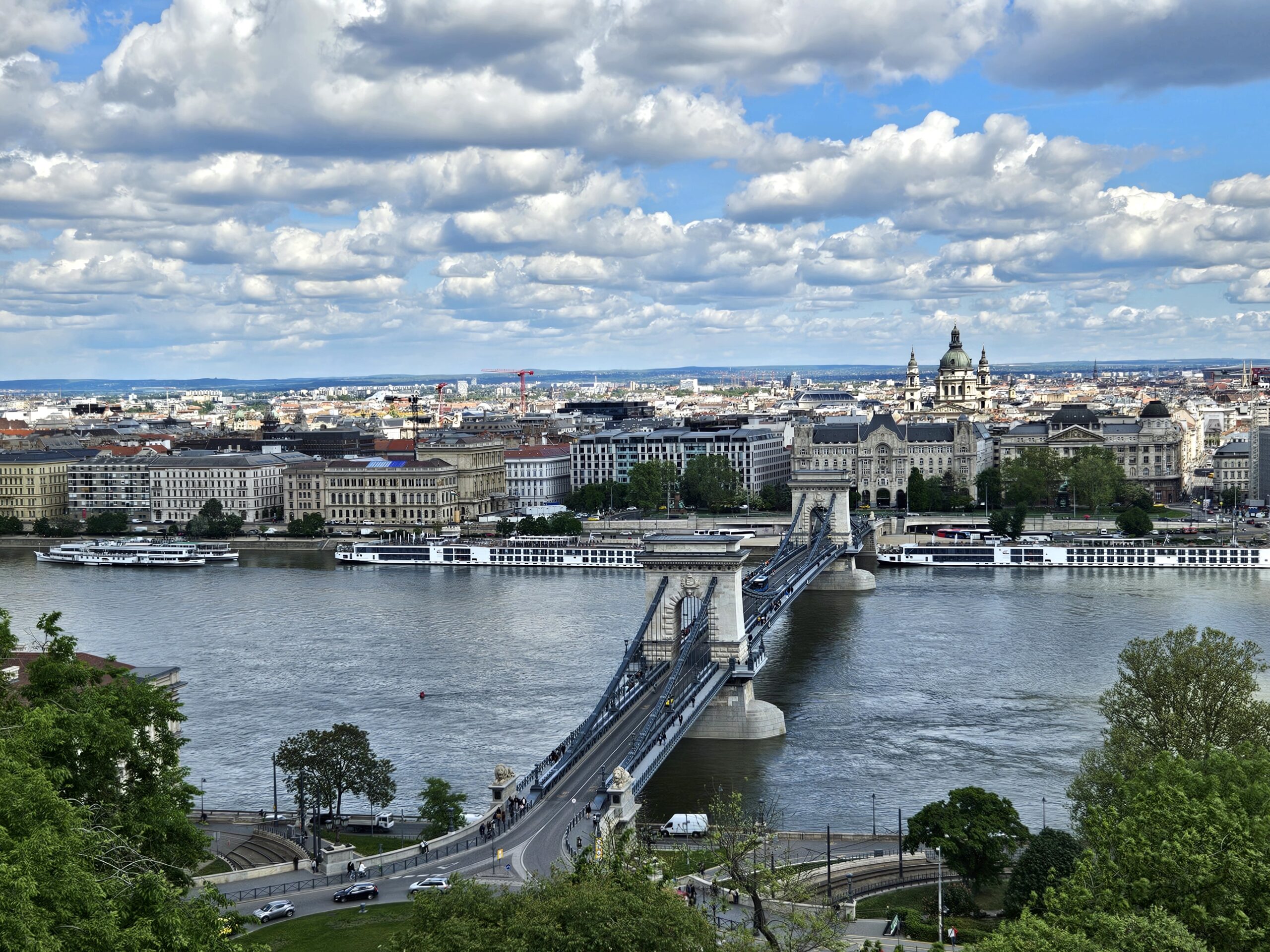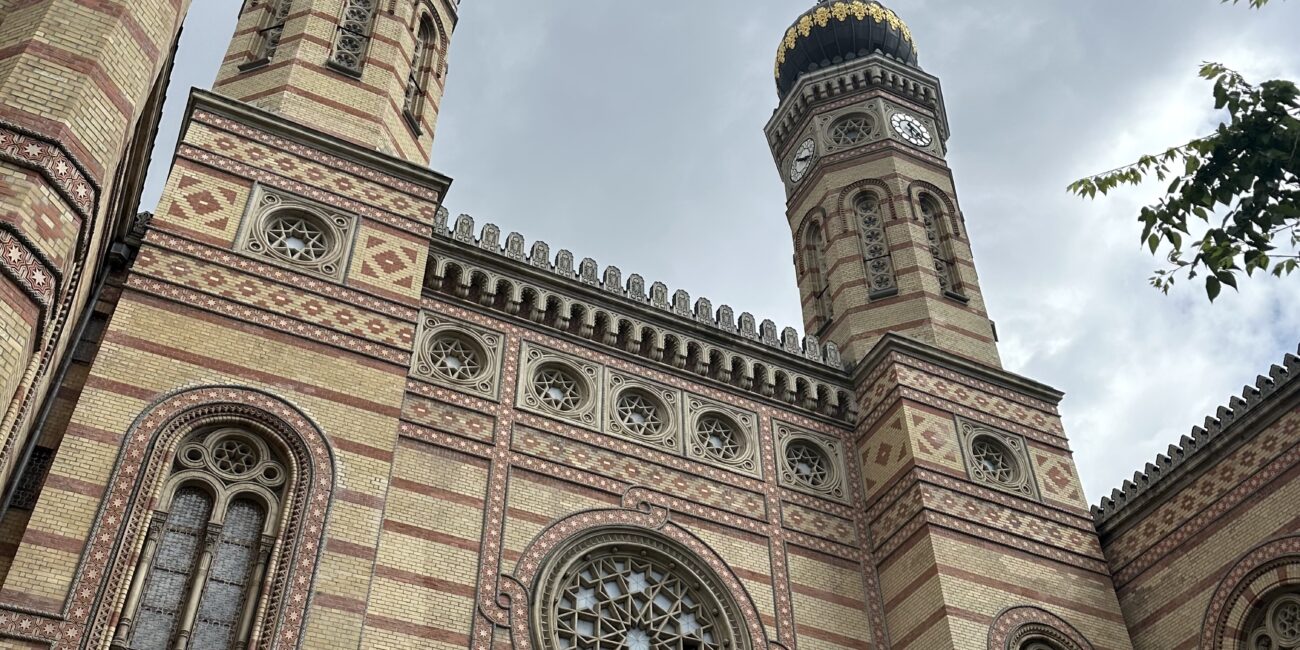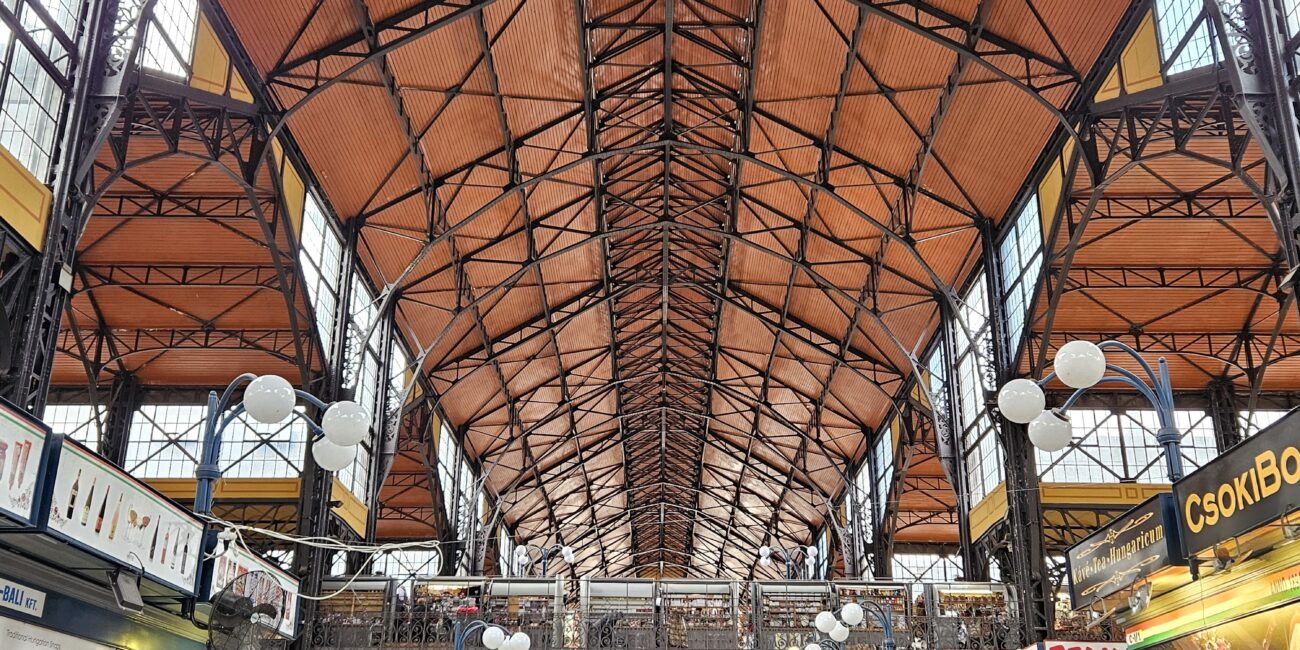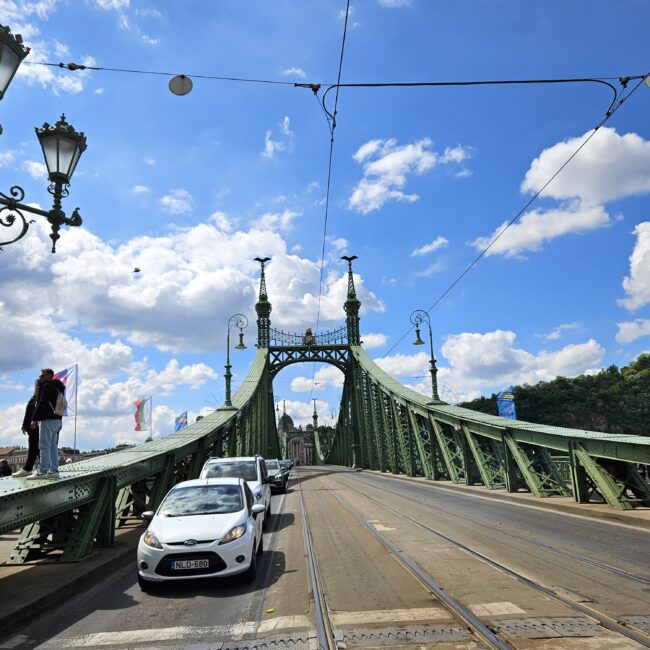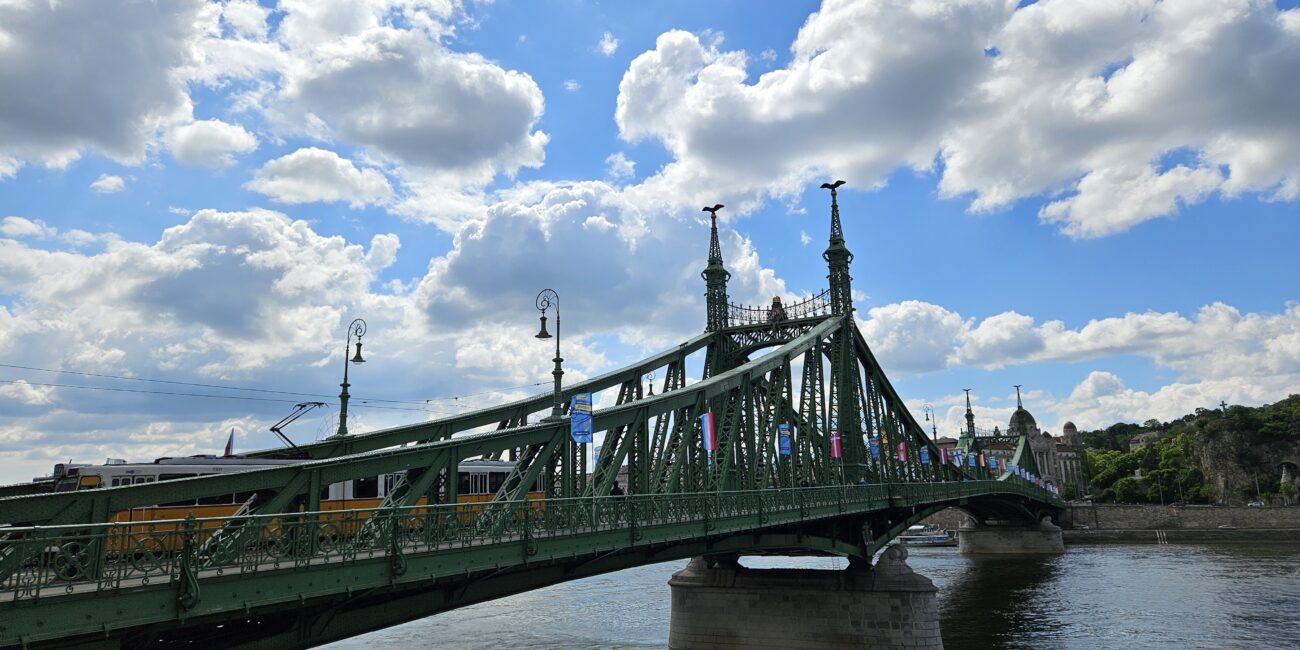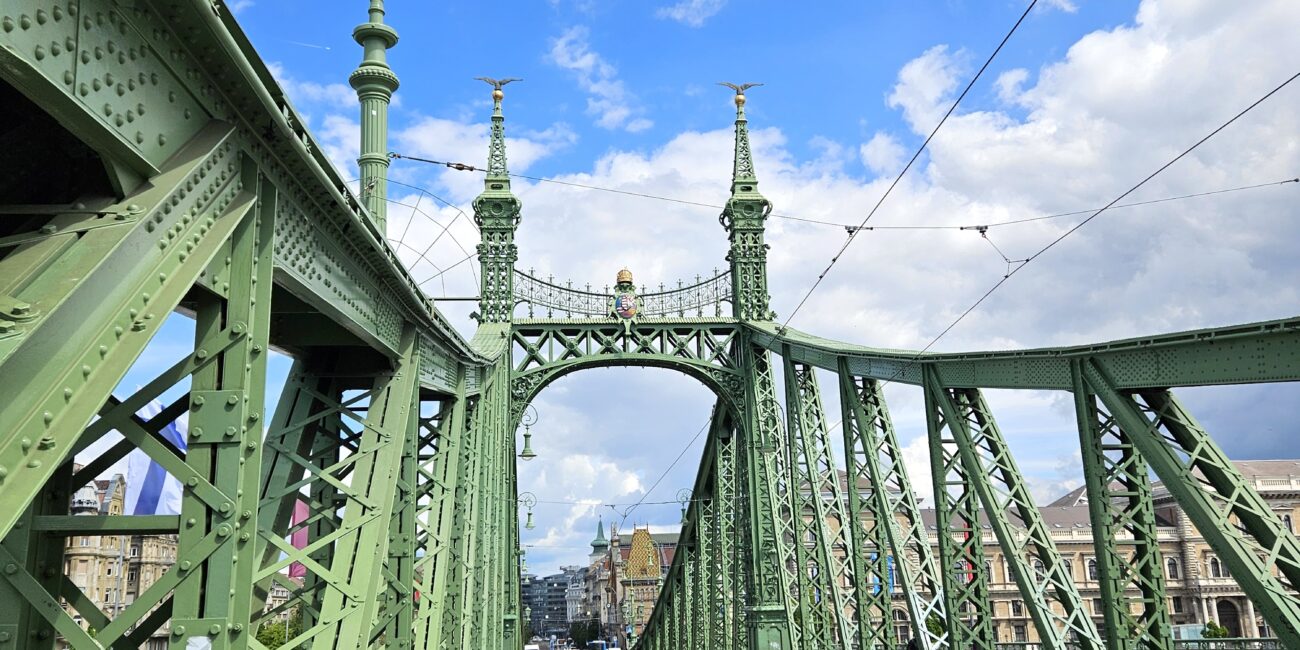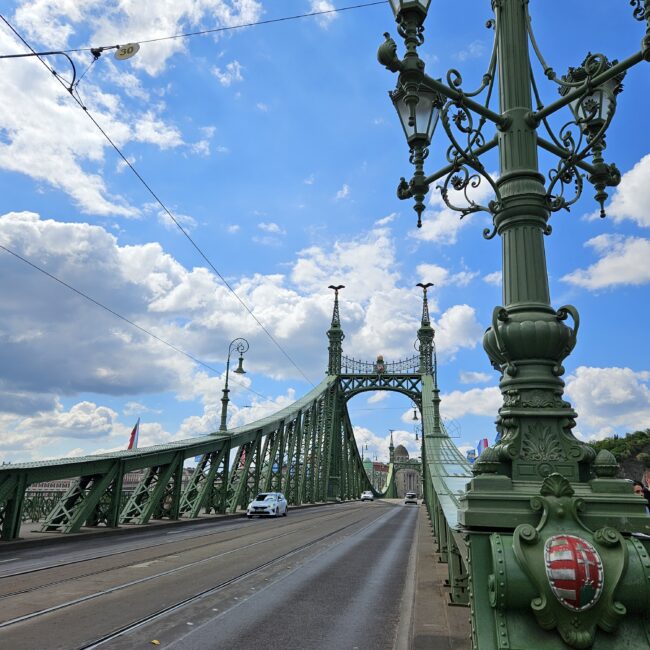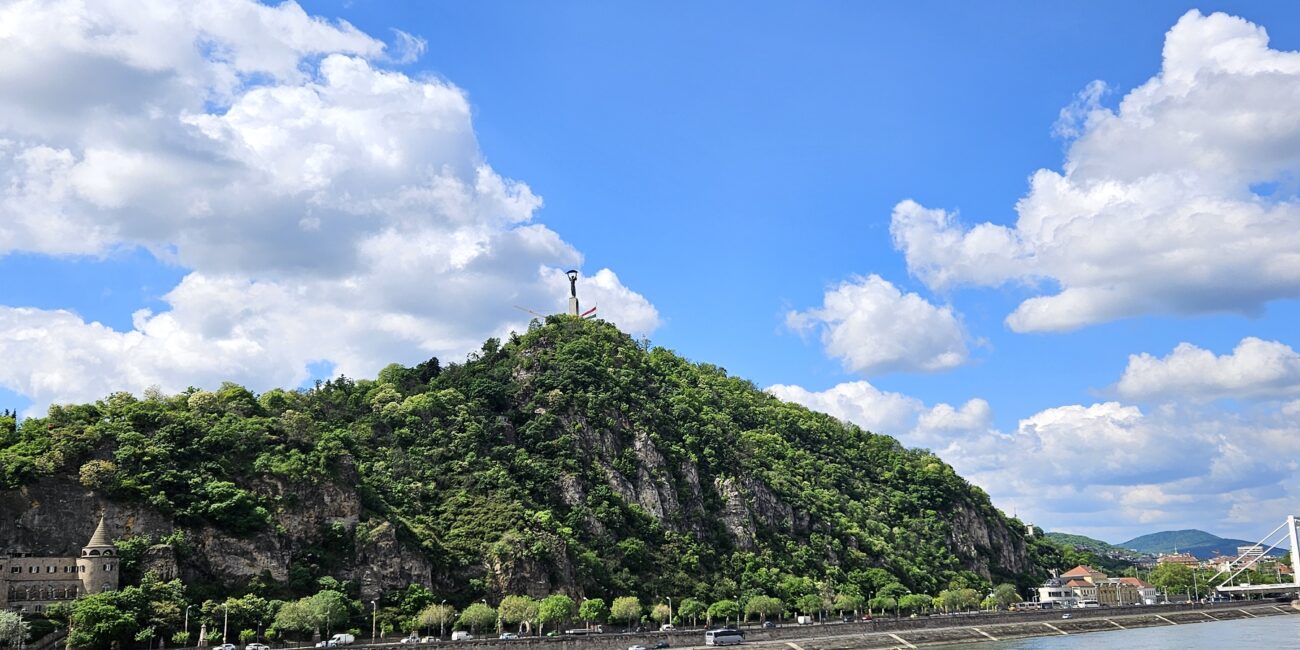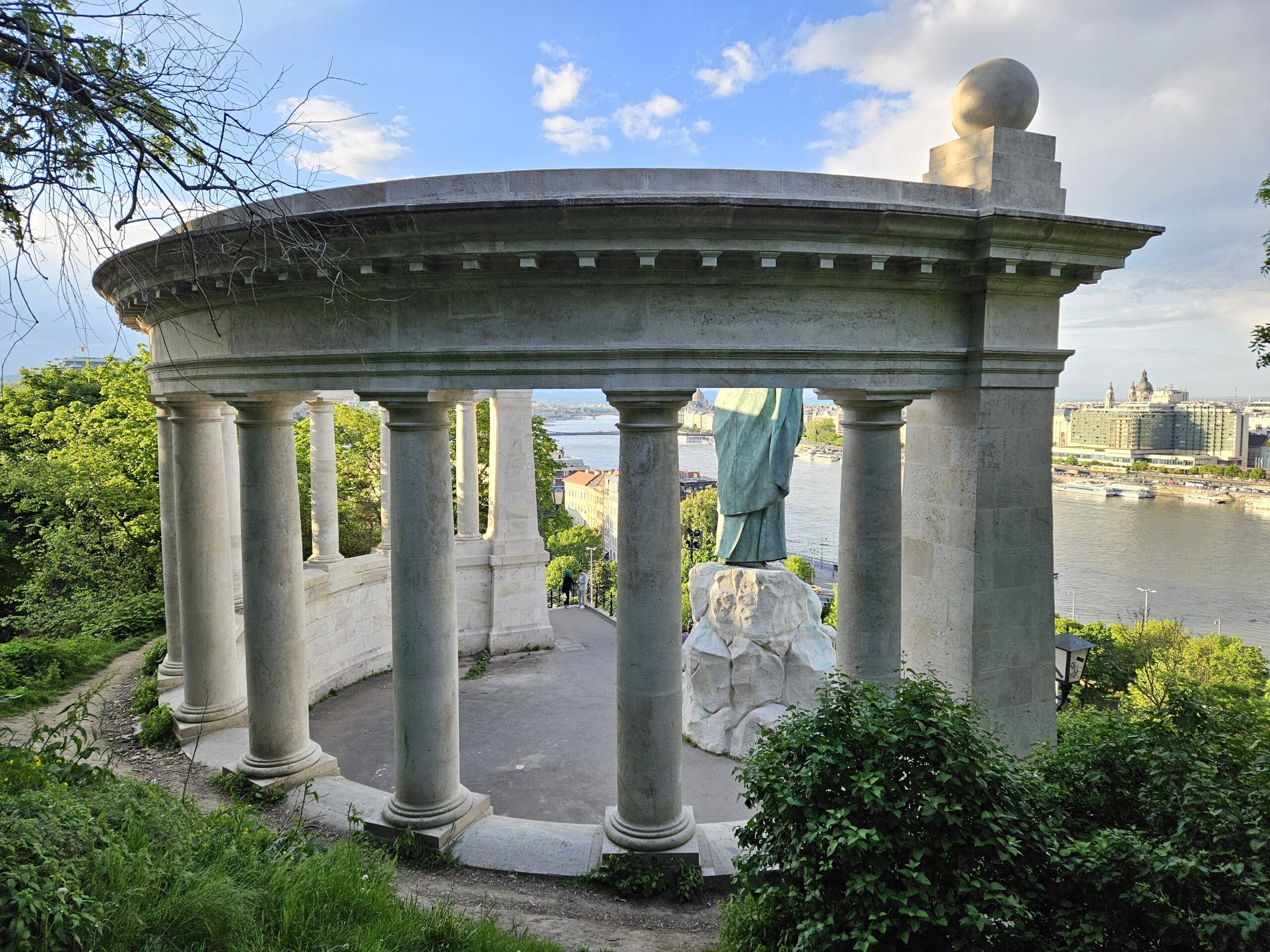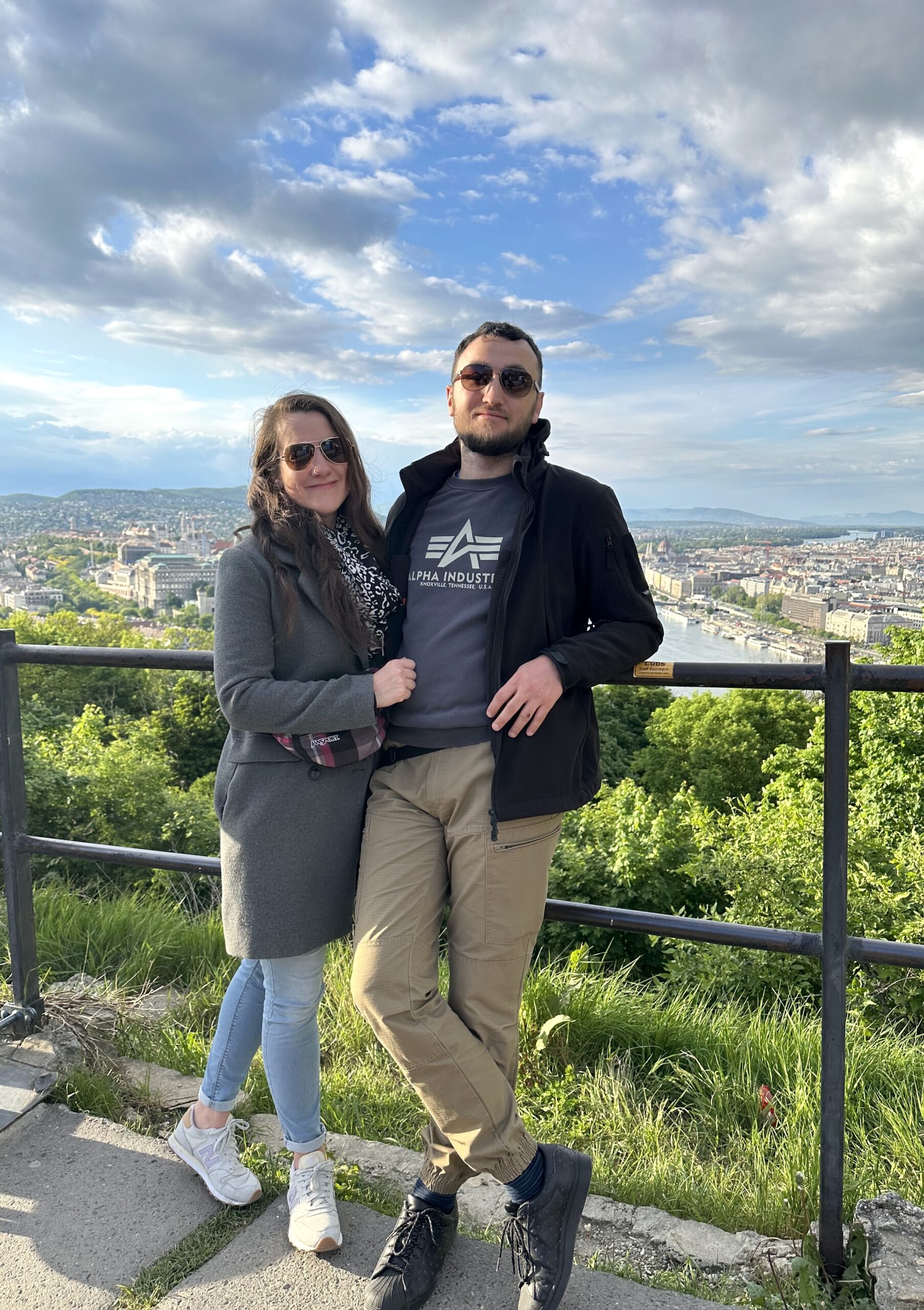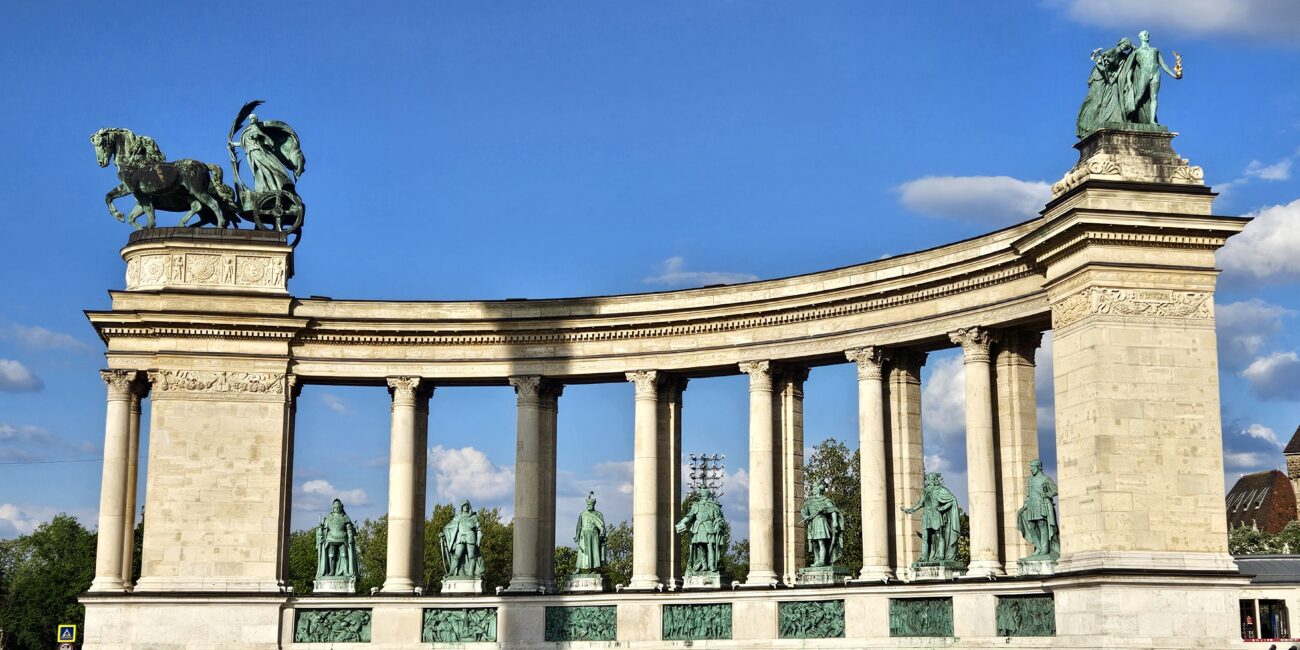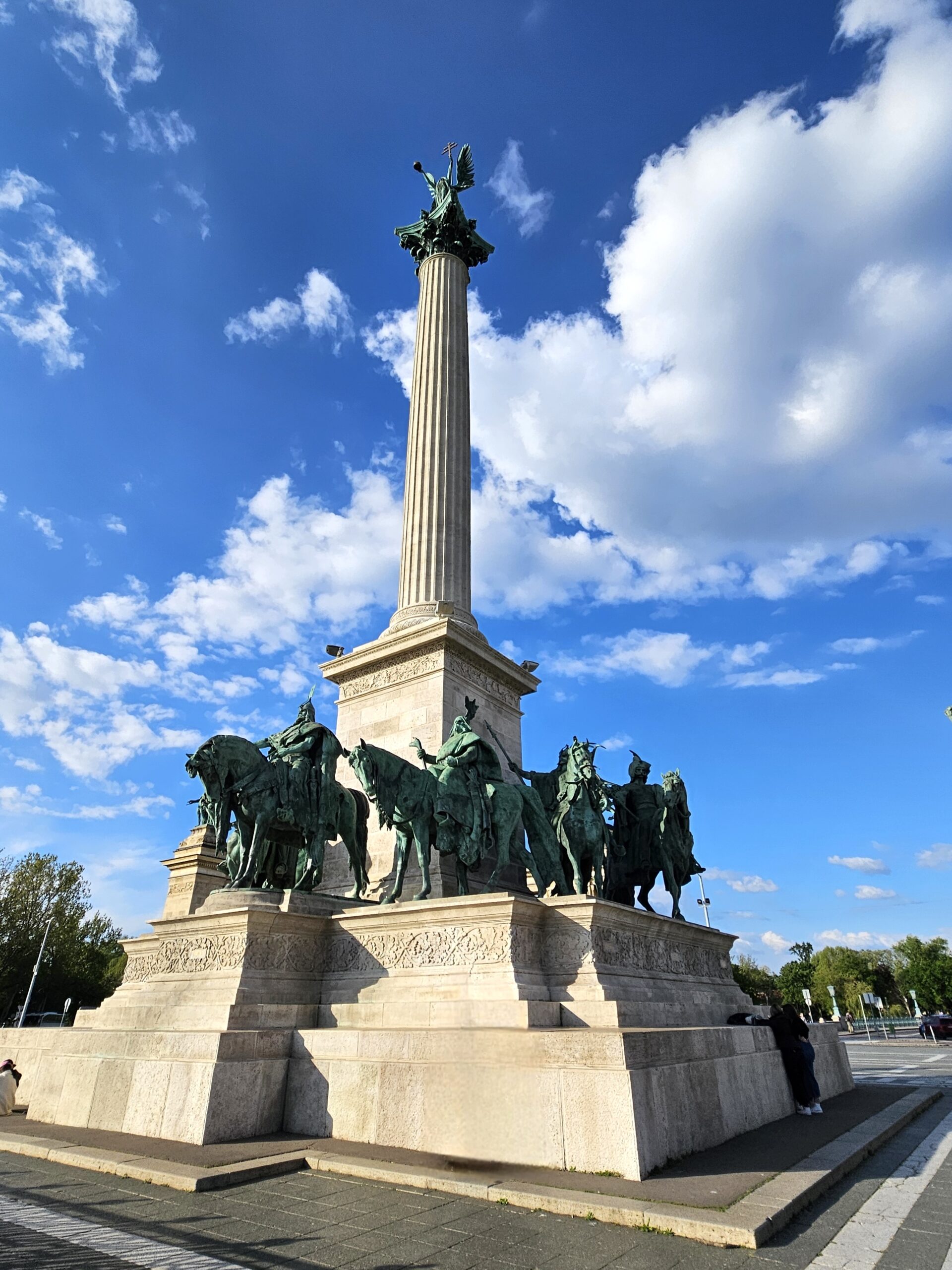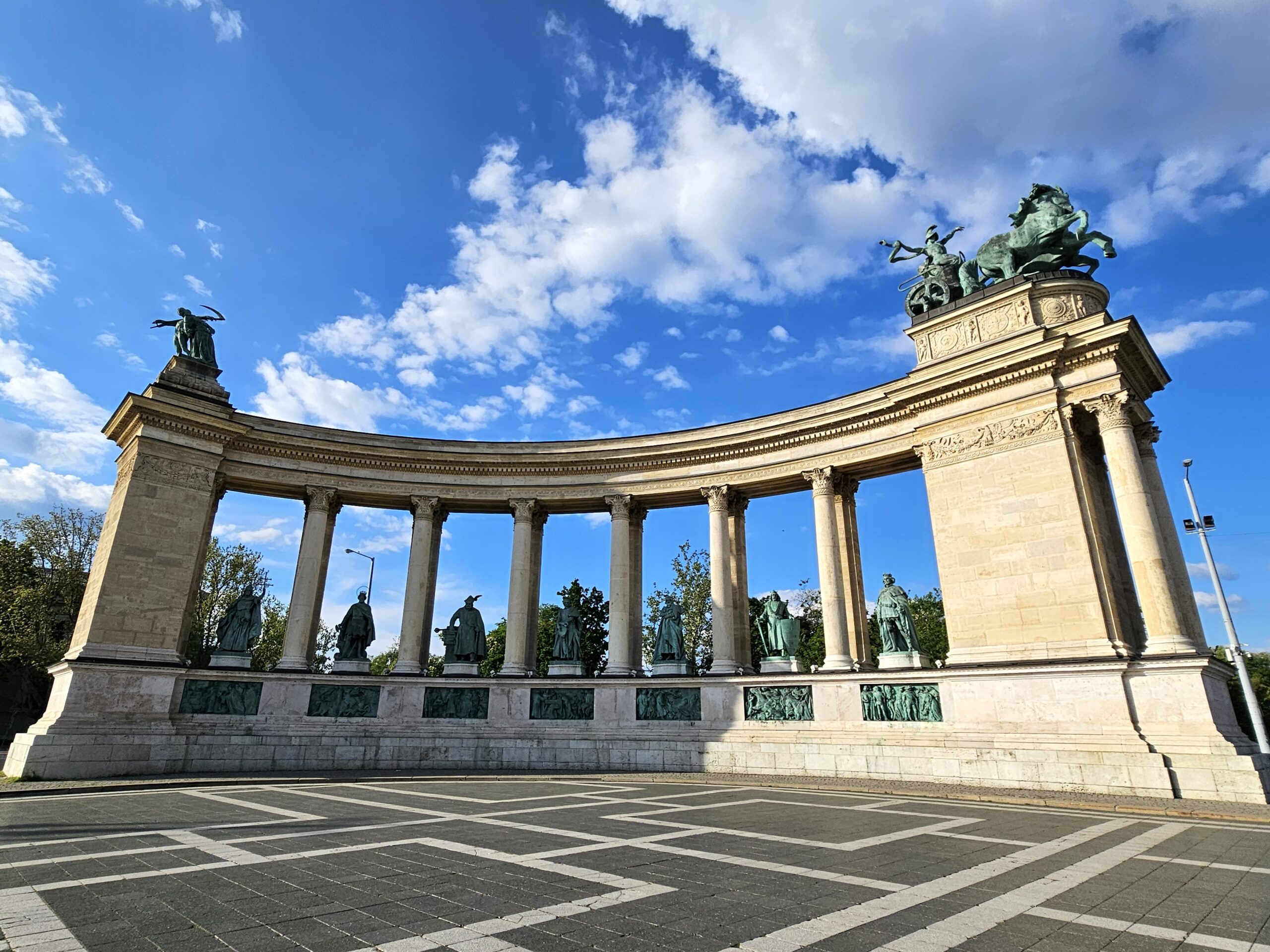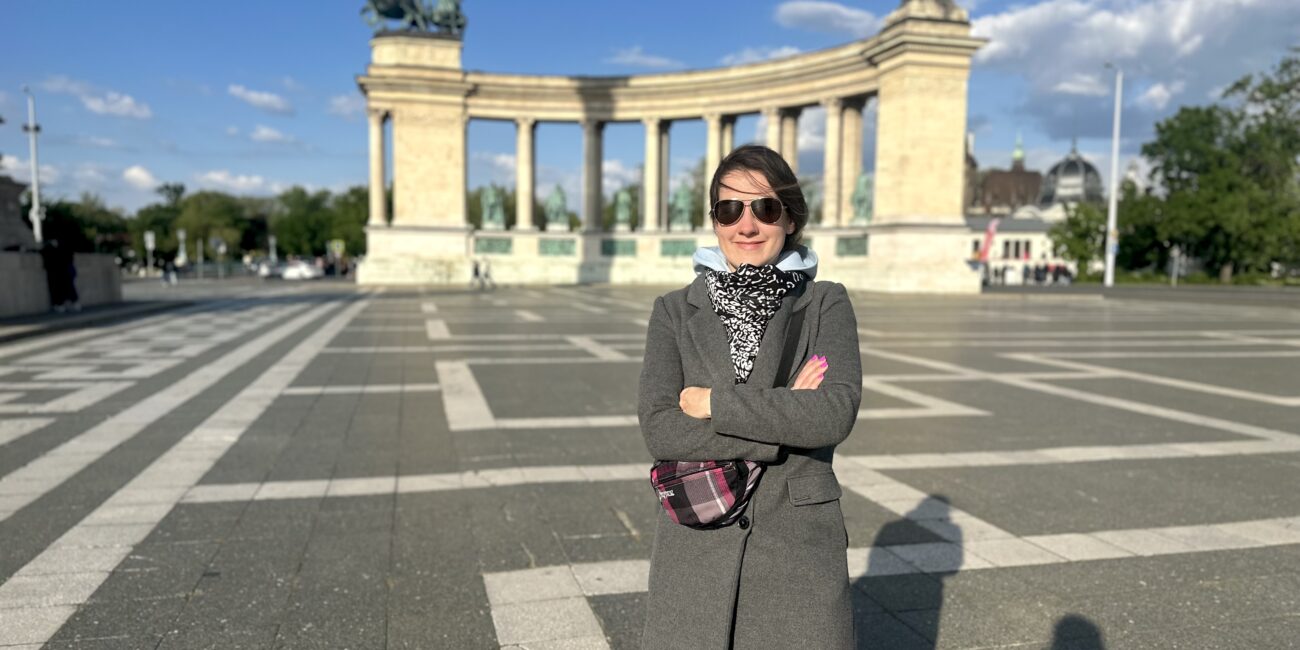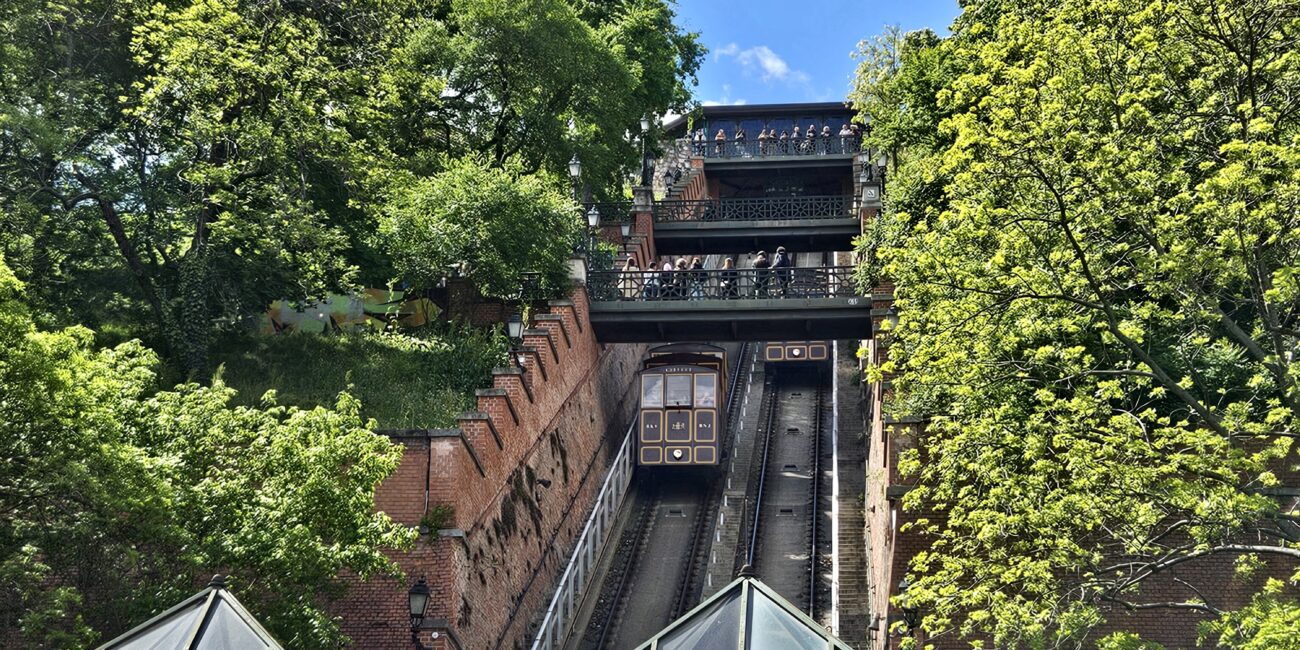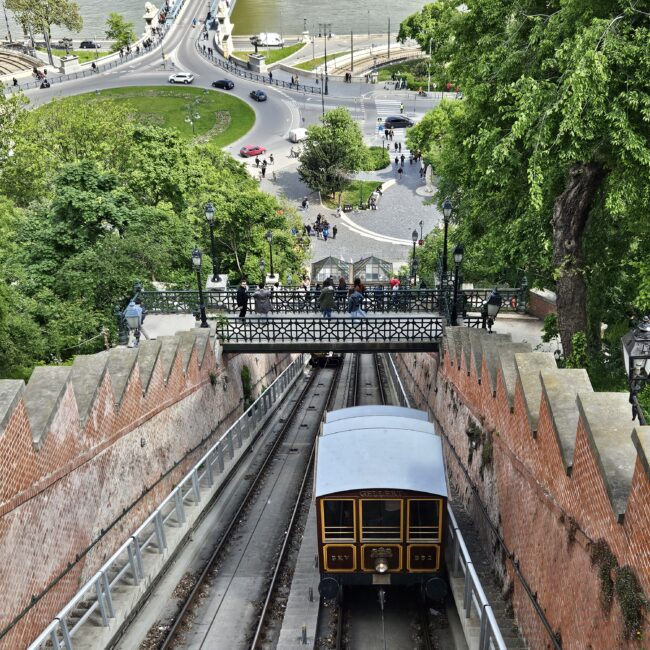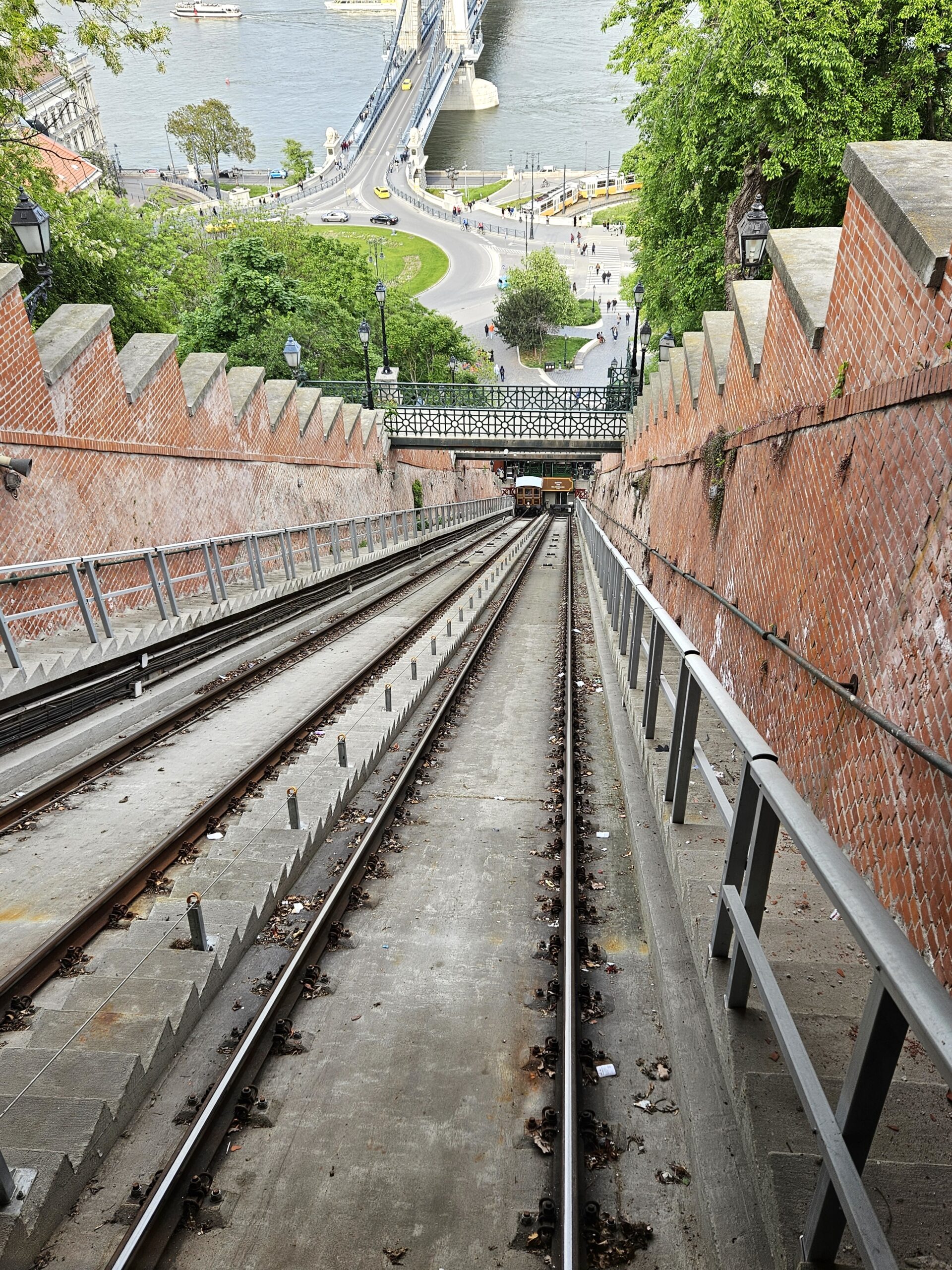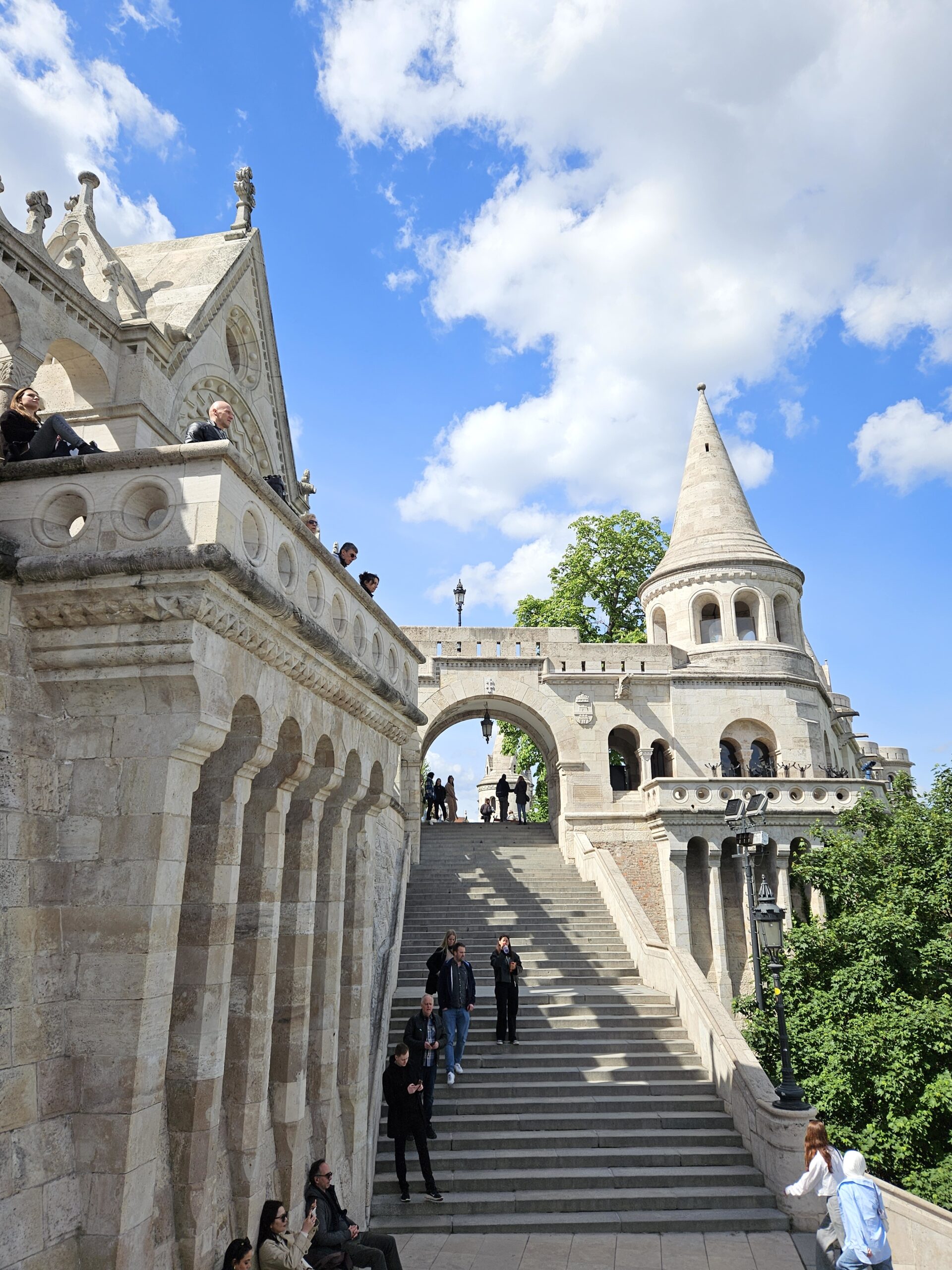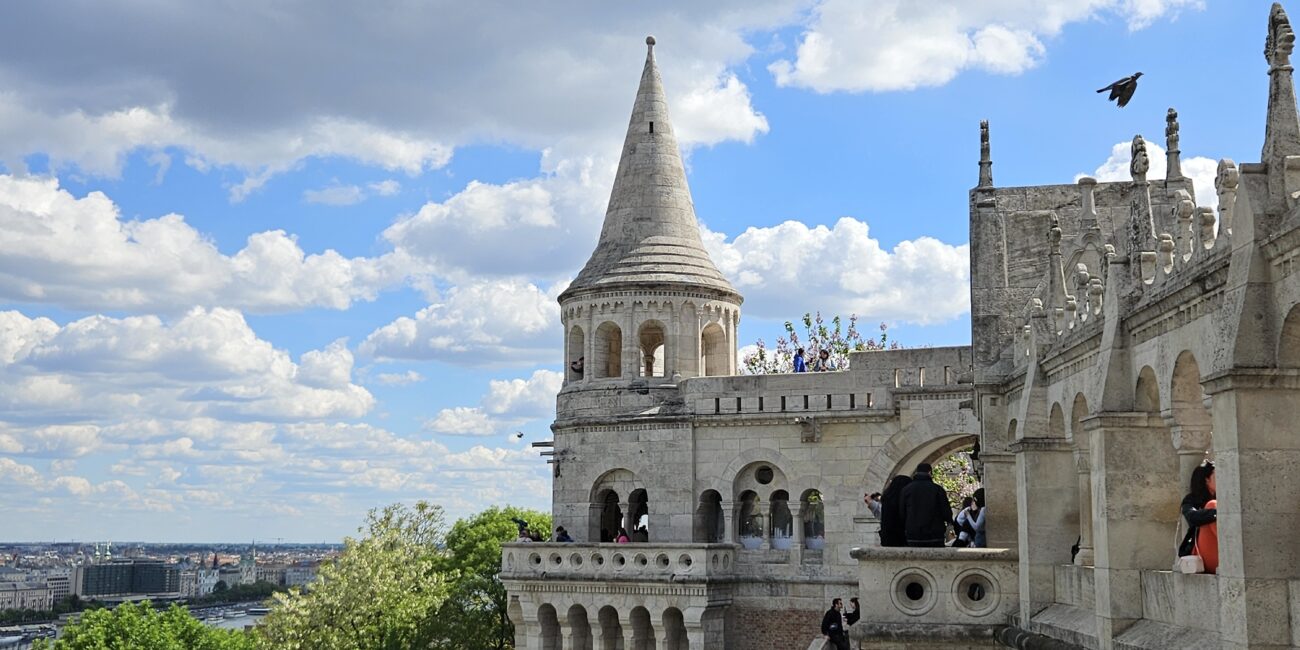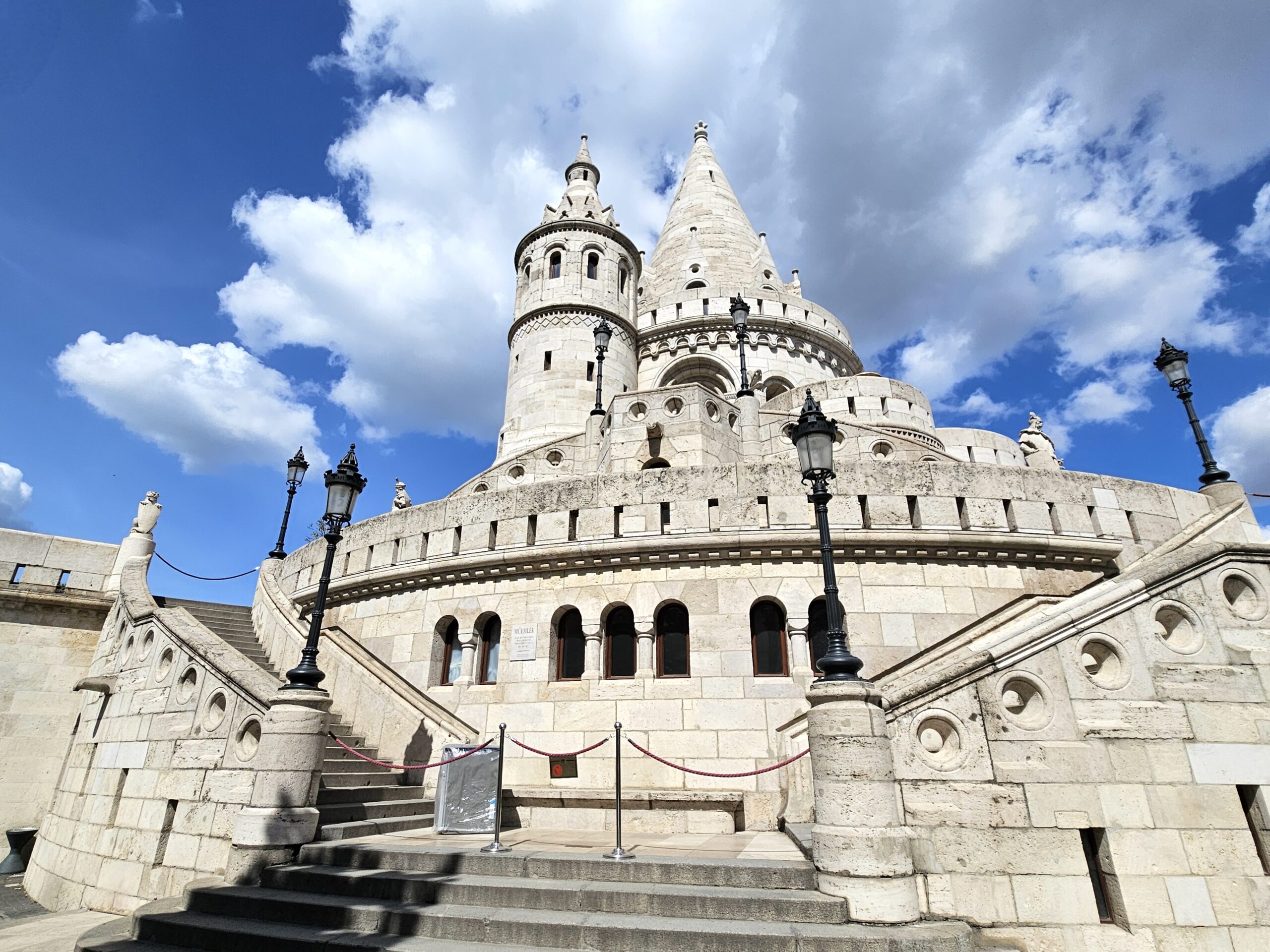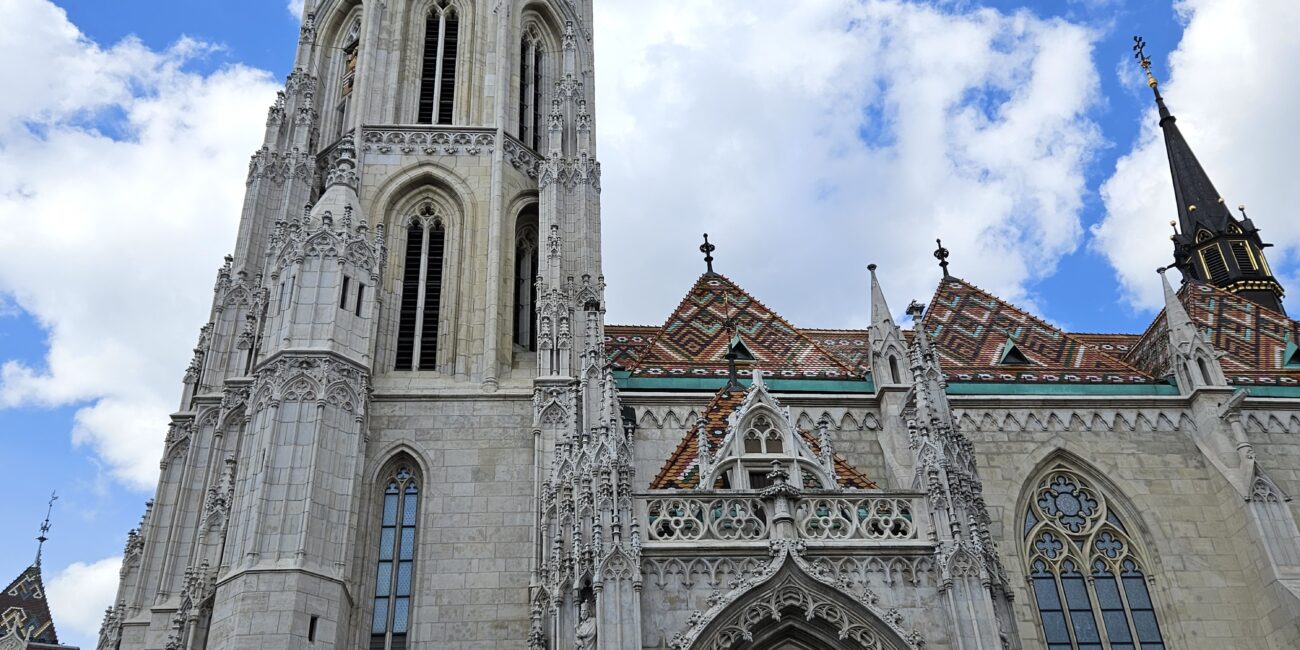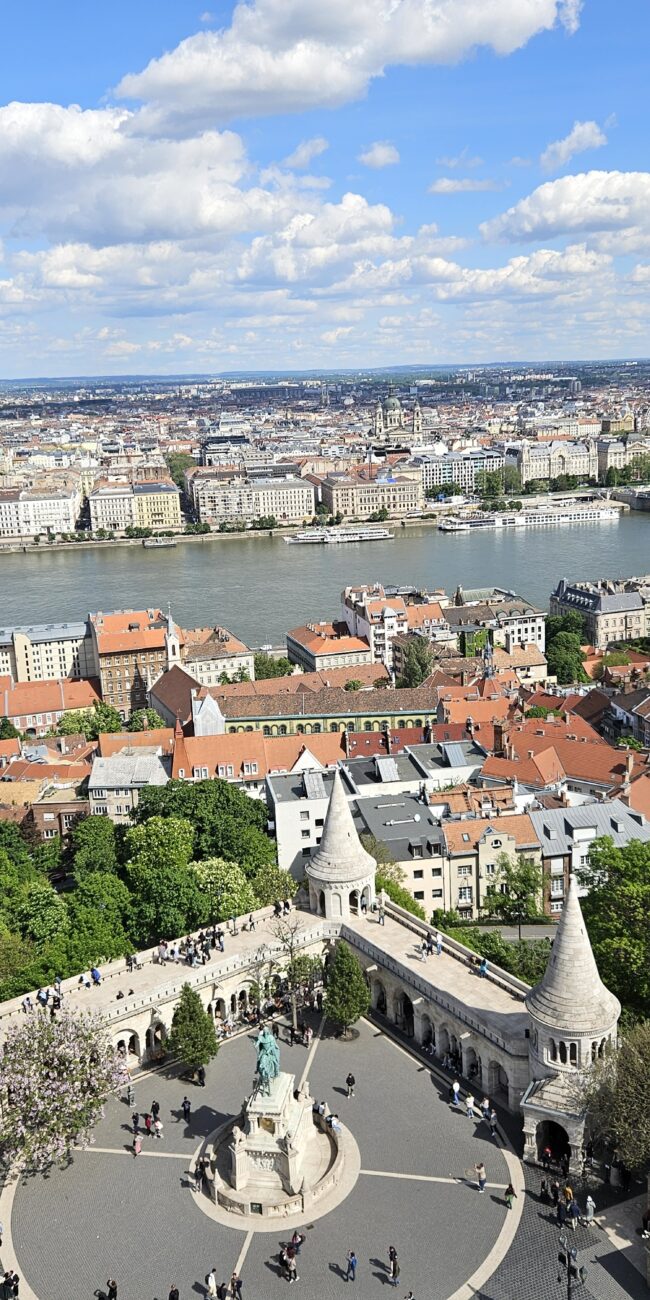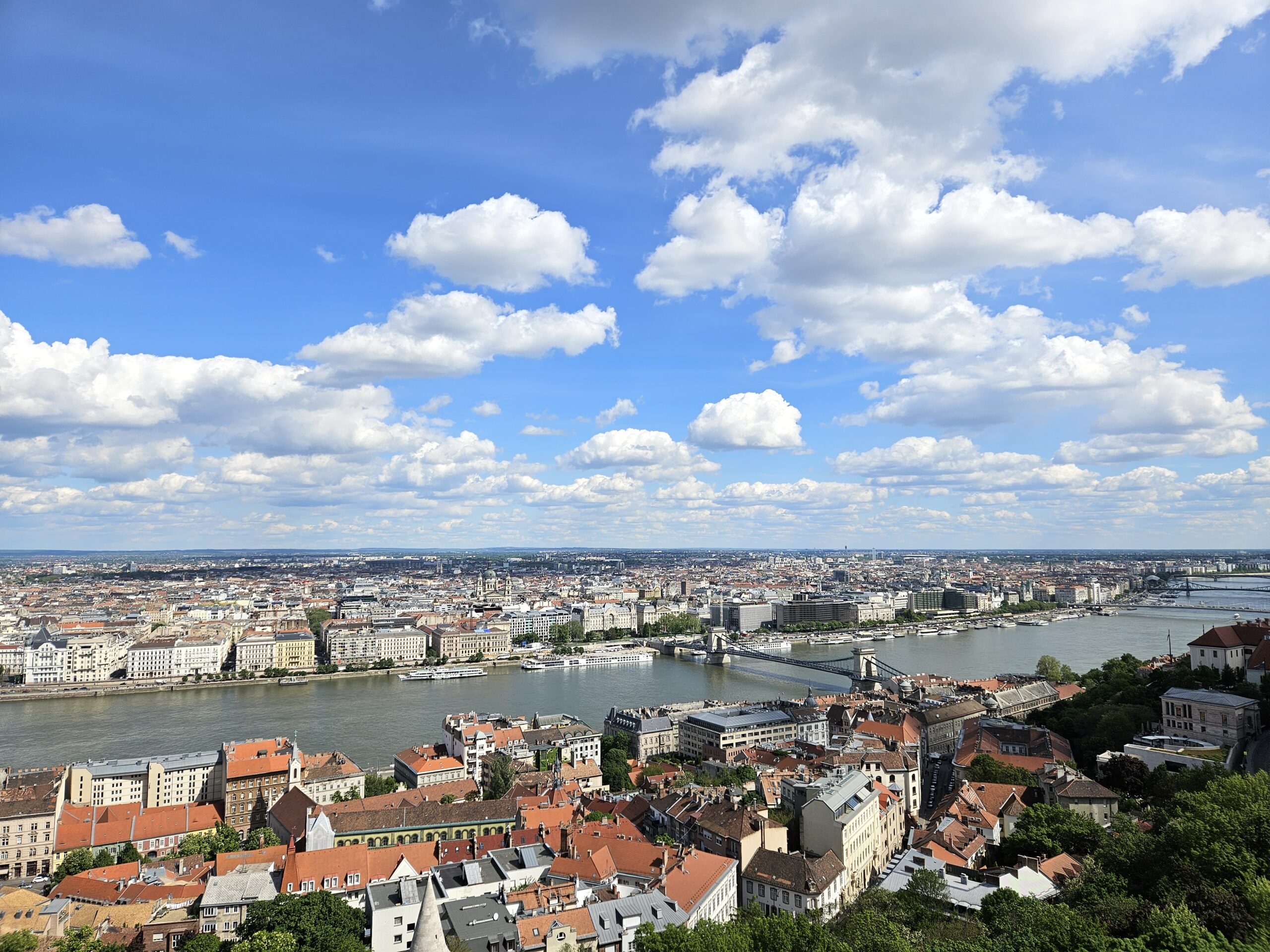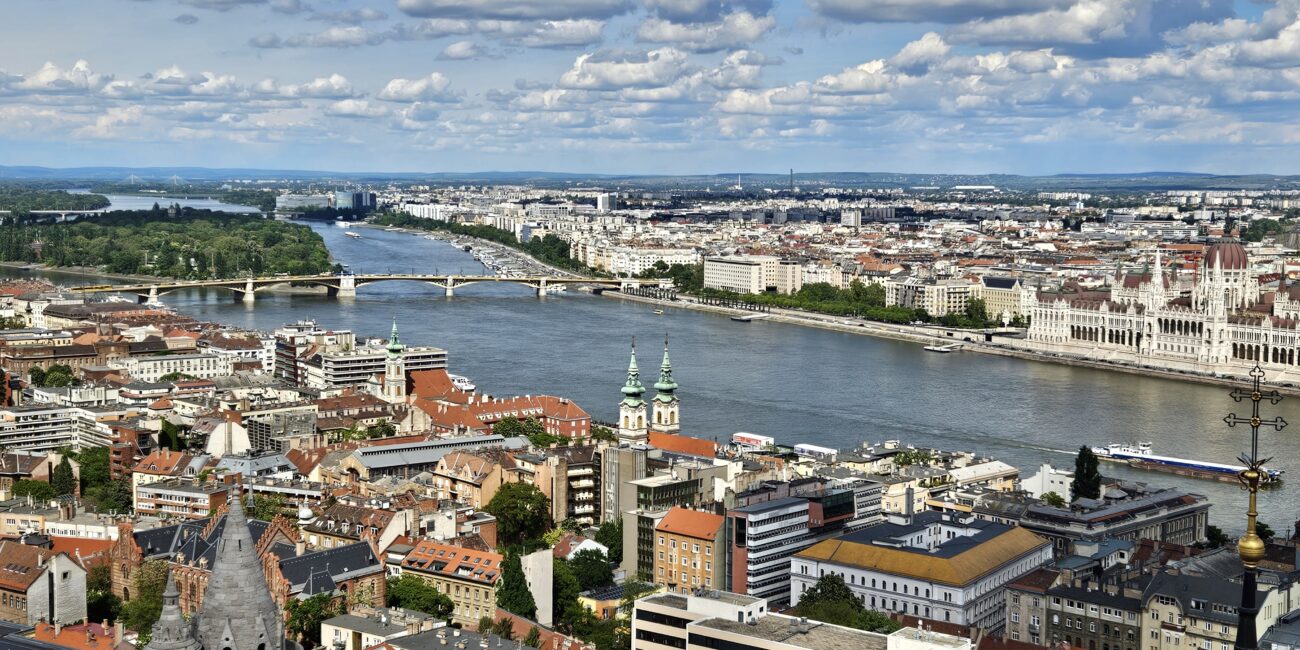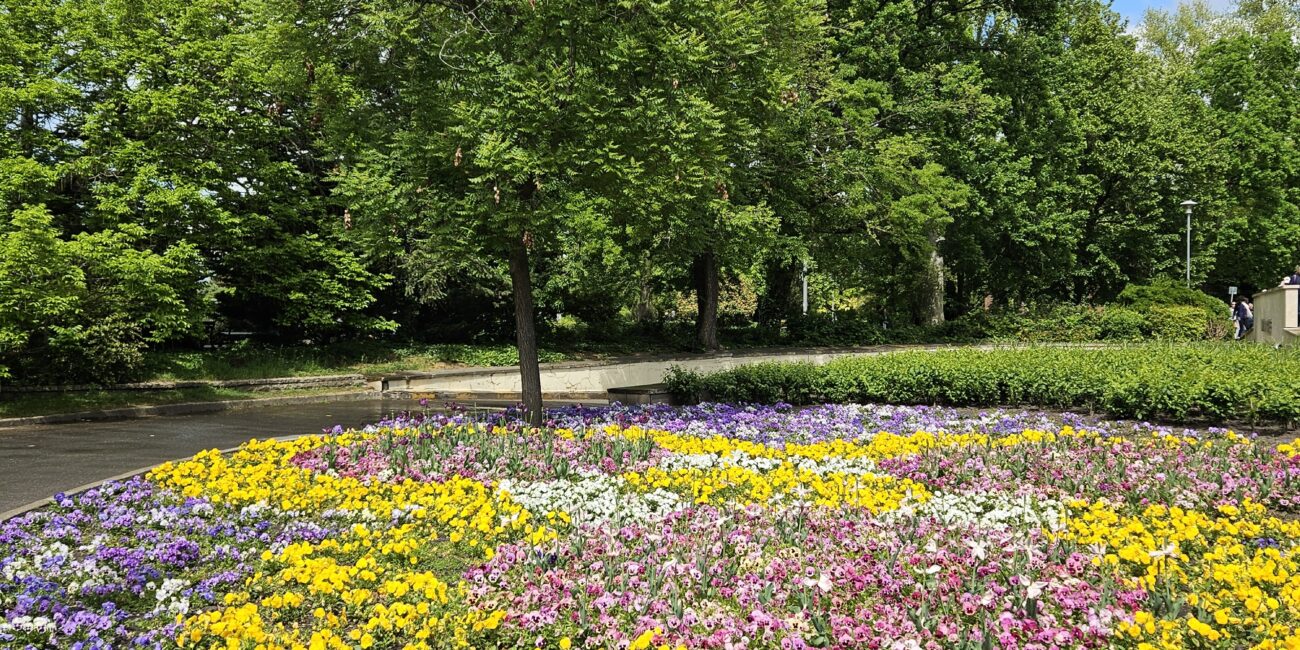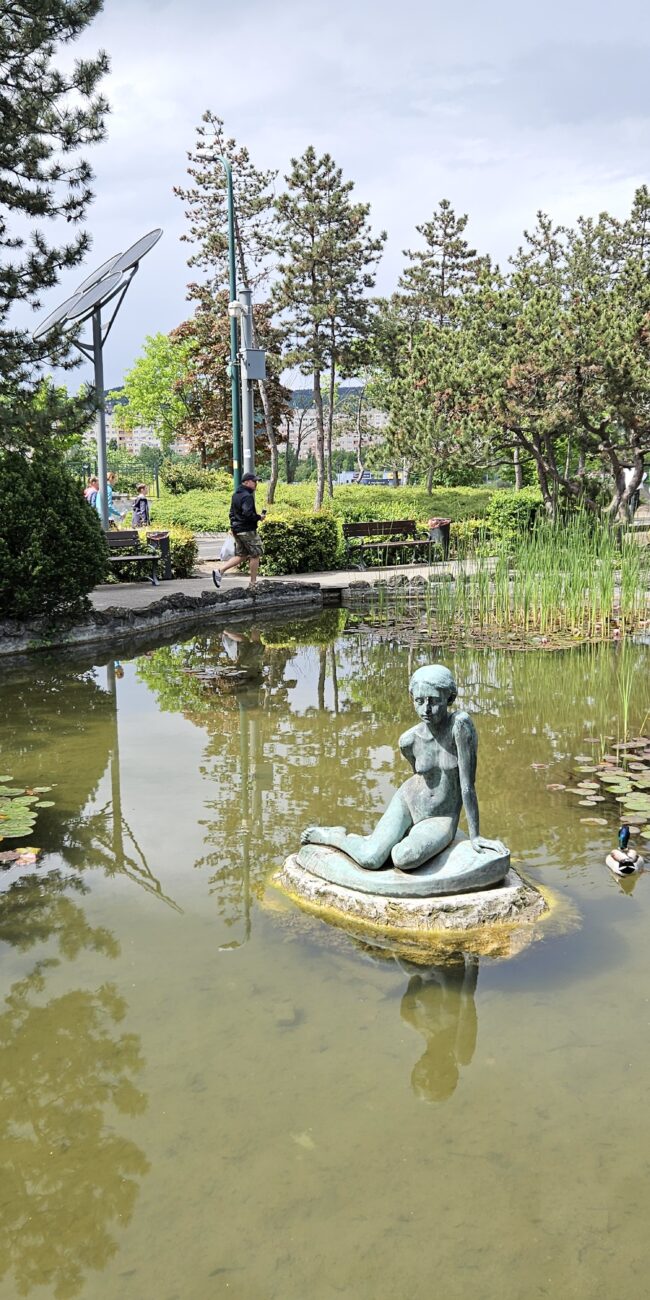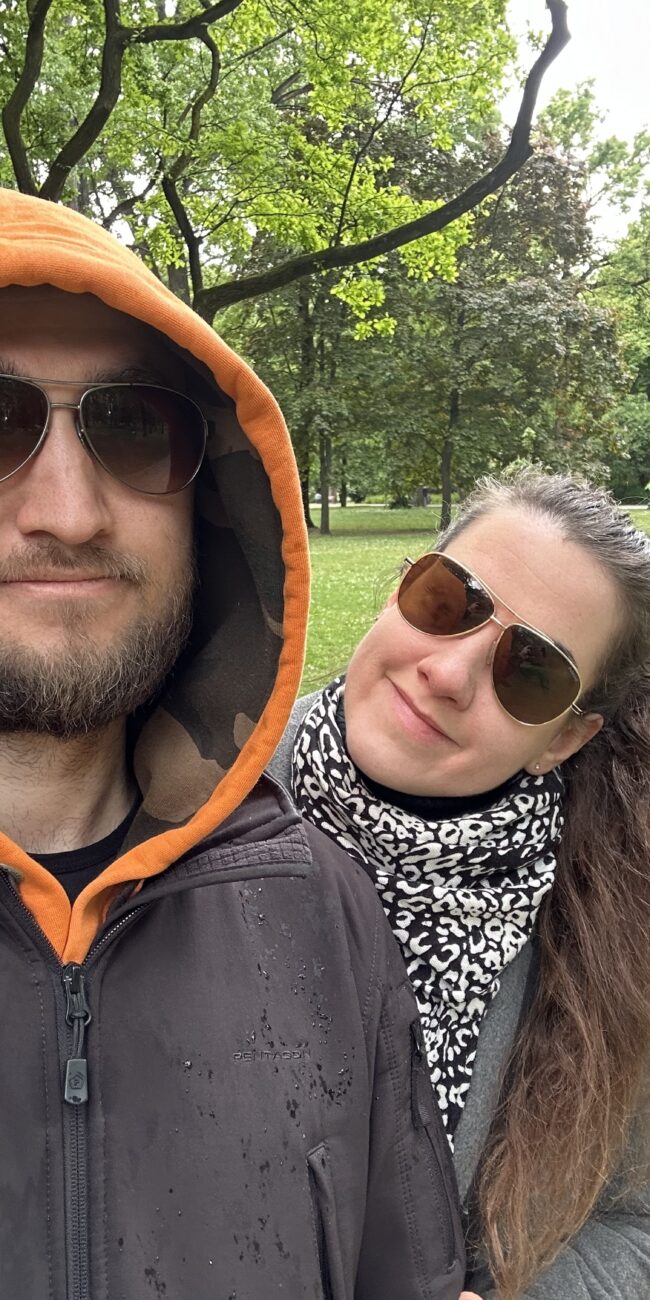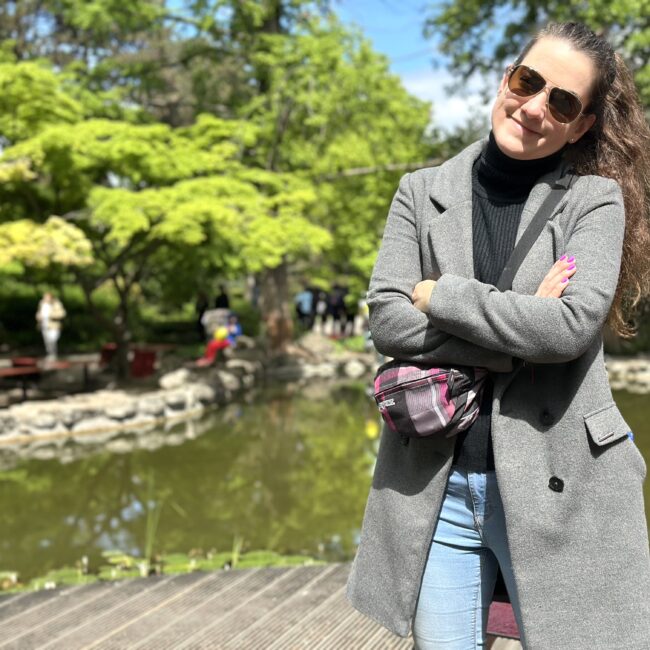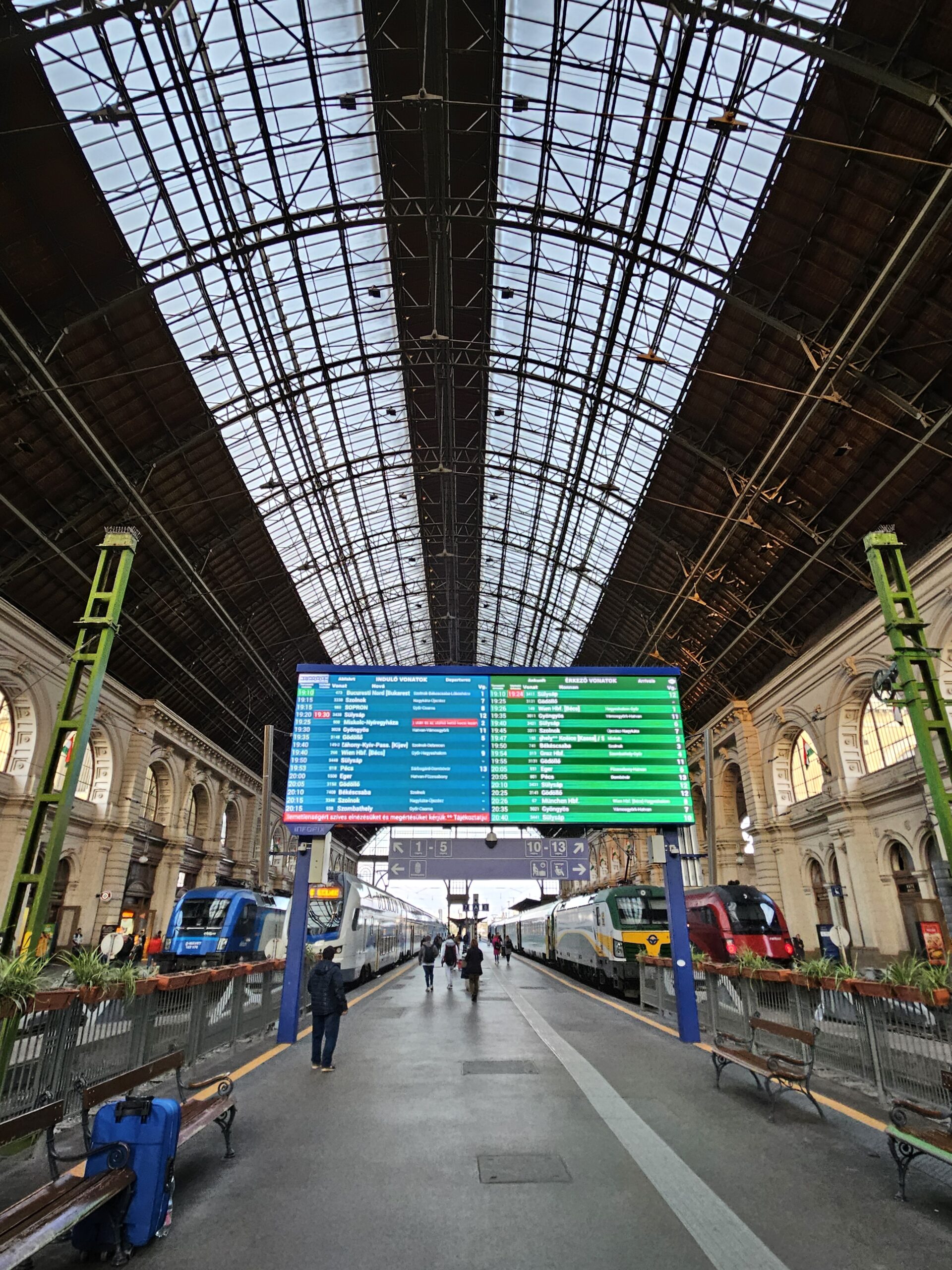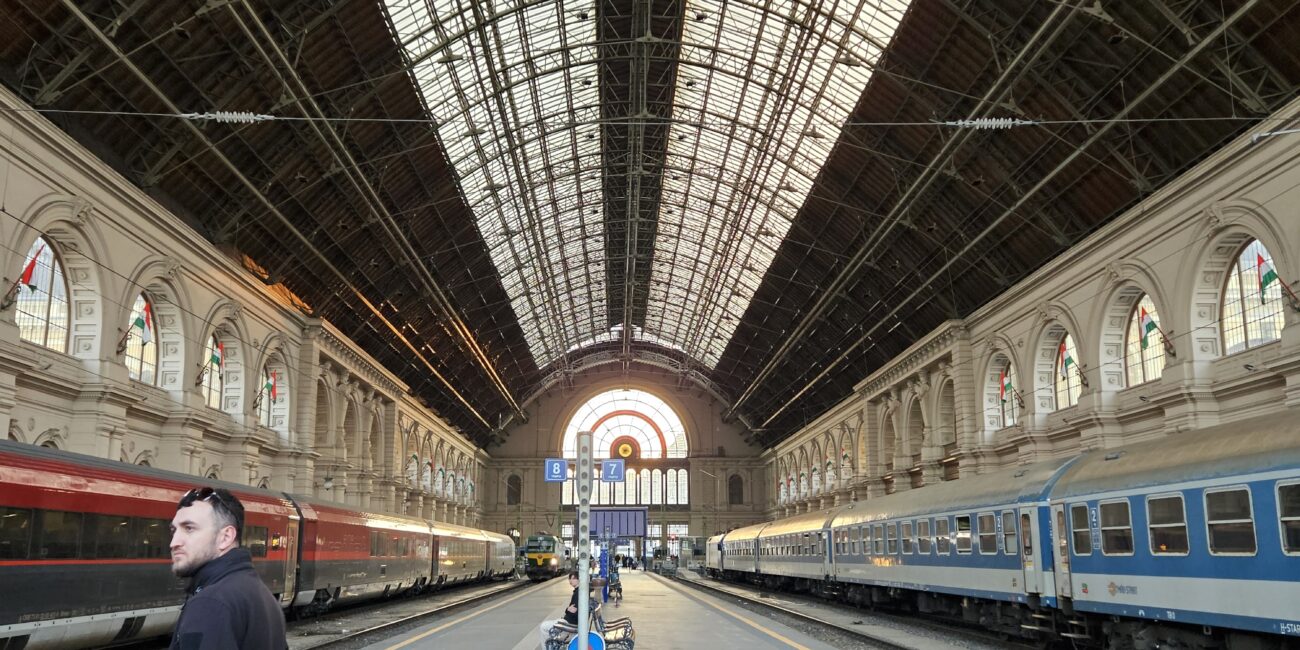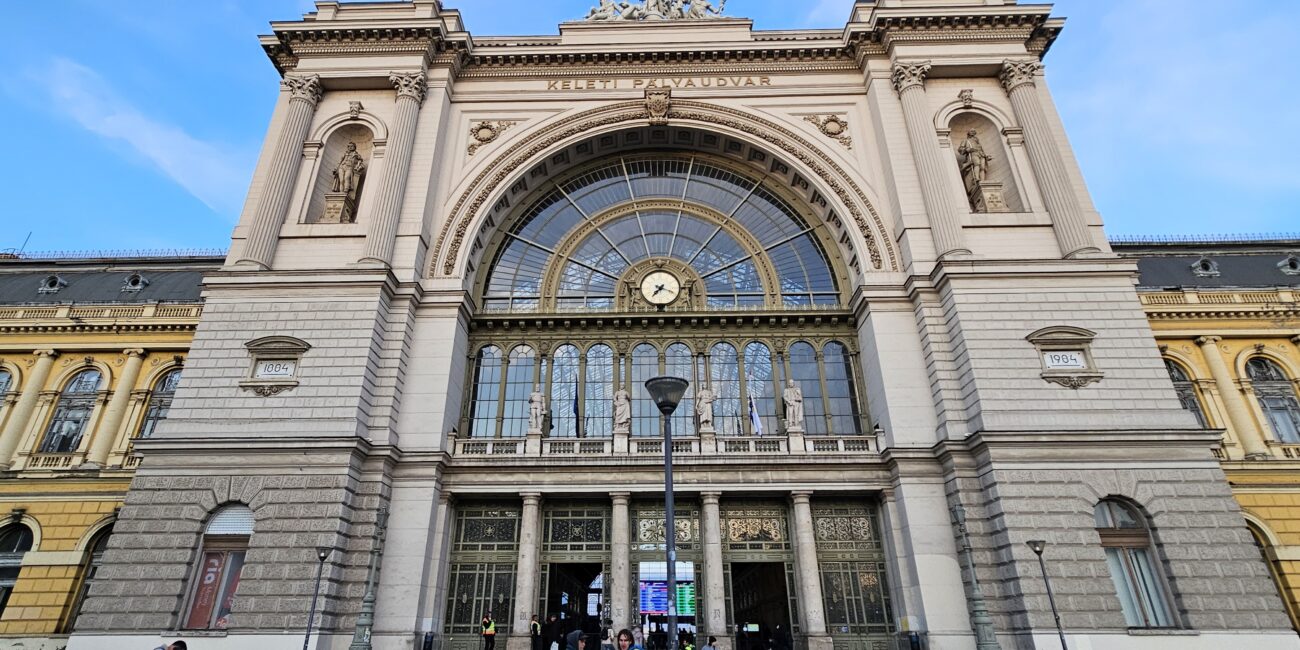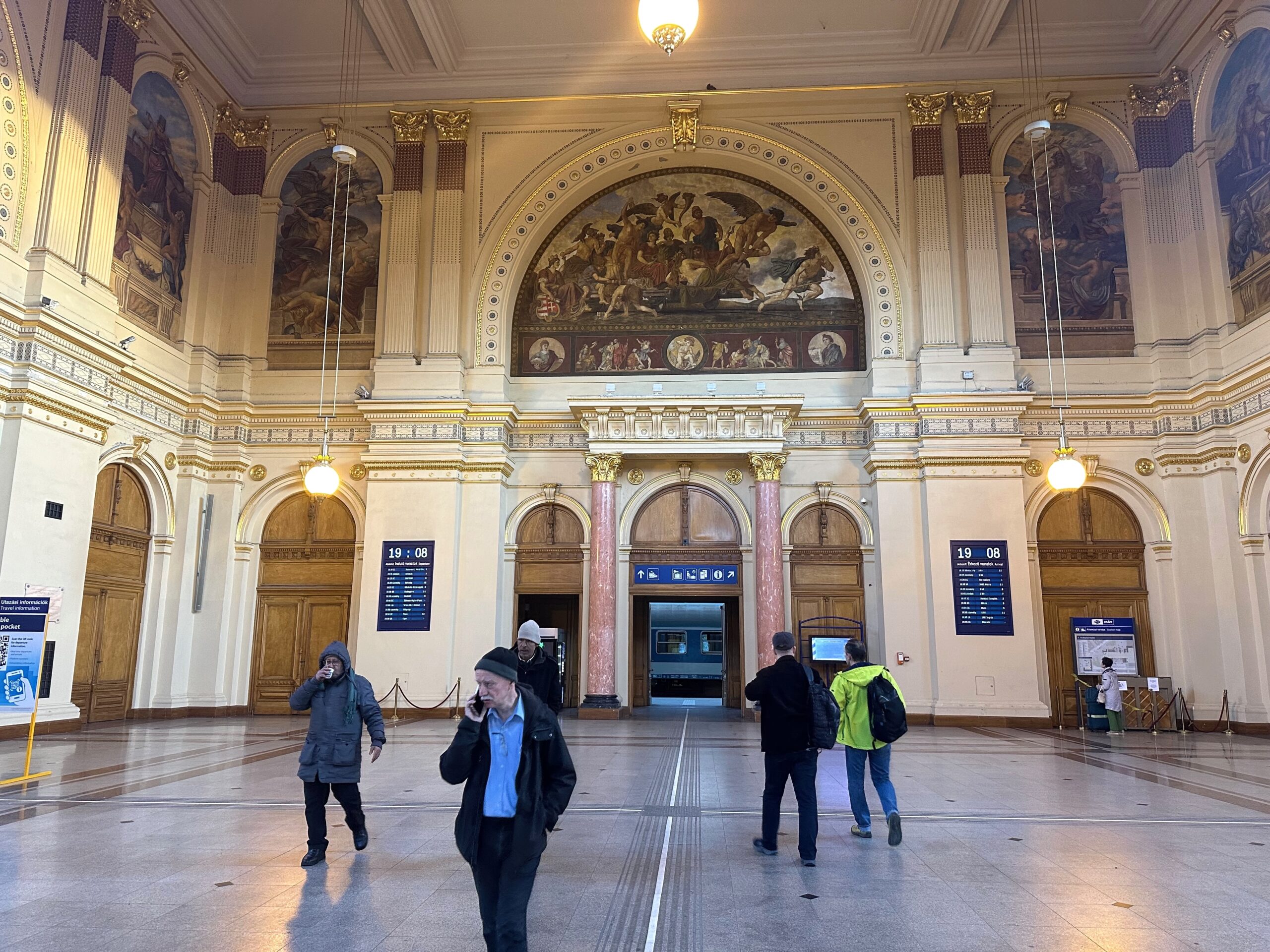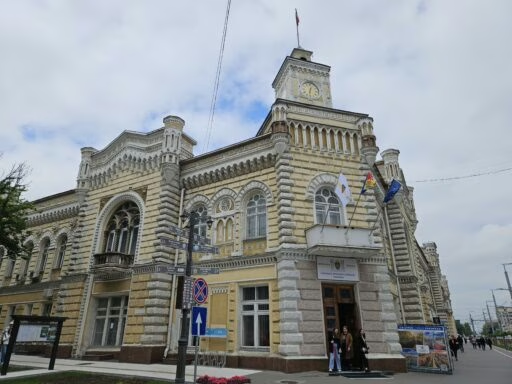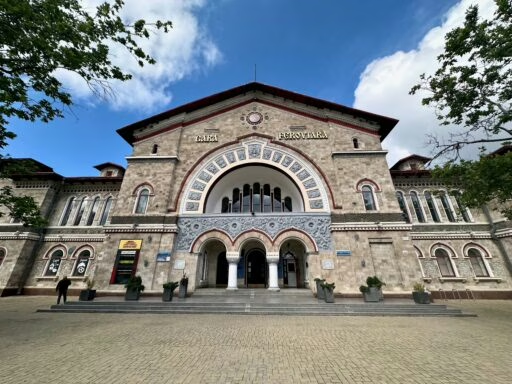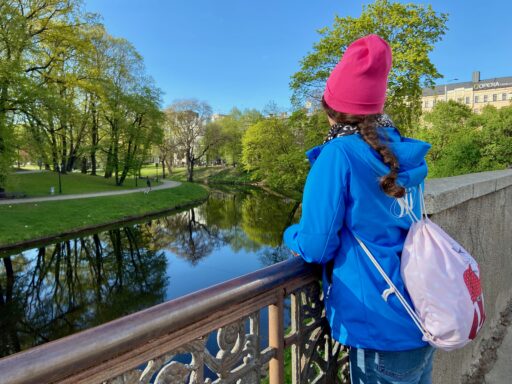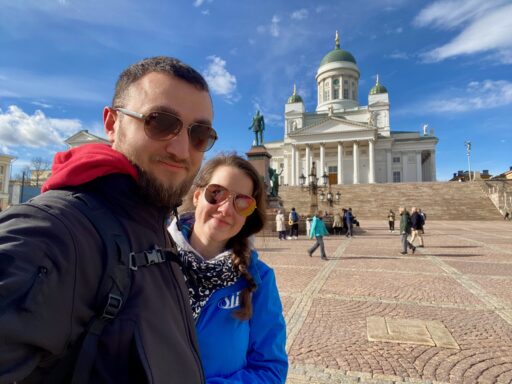This post is also available in:
Polski
Hello! 👋
During our short stay in Budapest, we decided to focus on the places that intrigued us the most and we considered worth visiting. Of course, with such limited time, it’s impossible to see everything, but we chose attractions that, in our opinion, best capture the spirit of the city. These weren’t just the most popular spots, but also those that had something unique to offer.
Budapest is a place that is easy to explore at your own pace, so even a short city break offers the opportunity to see many interesting things. In this article, we share what we managed to visit, and we hope our choices will inspire you.
If you would like to know more about our trip to Budapest in March 2024, please see our separate post ✍️ ➡️ – click here.
Shoes on the Danube Bank
“Shoes on the Danube Bank” is a poignant memorial in Budapest that honors the victims of the Holocaust. Unveiled on April 16, 2005, its main feature consists of 60 pairs of cast iron shoes from the 1940s. These symbolize the people who were shot by Hungarian fascists along the riverbank. The memorial is located on the Danube promenade, near the Hungarian Parliament, adding further historical significance and local context.
Its simplicity and deeply moving symbolism encourage reflection on the tragic events of World War II. Furthermore, its central location in the city attracts many tourists to visit this site. Though small, the memorial leaves a profound impact and prompts contemplation. Therefore, when visiting Budapest, it’s worth stopping here to better understand the dramatic history of this period. In this way, we can honor the victims and remind ourselves of the importance of remembering the past.
Budapest parliament building
The Parliament building in Budapest, known as Országház, is one of Hungary’s most recognizable symbols. Located on the banks of the Danube, in Kossuth Square, it impresses with its Gothic Revival architecture and imposing size.
Construction of the monumental building began in 1885, based on Imre Steindl’s design. It was completed in 1902. The Parliament is 268 meters long, 123 meters wide, and 96 meters high, making it one of the largest parliamentary buildings in the world. Its facade is adorned with numerous sculptures of Hungarian rulers, princes, and military leaders, highlighting its historical significance.
The Parliament is open to visitors, with guided tours available in several languages, making it more accessible to international tourists. For Polish-speaking visitors, an audio guide is also available. During the visit, you can explore the most important rooms, learn about the building’s history, and discover how the Hungarian parliament functions. Tickets can be purchased online or at the on-site ticket counters, making planning easier.
During our last trip, we didn’t have enough time to book a visit. However, we hope to explore the interior on our next trip. It’s a place worth experiencing to fully appreciate its unique character.
For more information, visit the official website – click here.
Chain Bridge in Budapest
The Chain Bridge in Budapest, also known as Széchenyi Bridge (Hungarian: Széchenyi lánchíd), is one of the most iconic symbols of the city. Located over the Danube River, it connects the two historic parts of Hungary’s capital: Buda and Pest.
Construction of the bridge began in 1839 under the initiative of Count István Széchenyi, and it was completed in 1849. The design was created by English engineer William Tierney Clark, with Scottish engineer Adam Clark overseeing the construction. The bridge measures 375 meters in length, 14.8 meters in width, and its main span stretches 202 meters. At the time of its completion, it was one of the longest suspension bridges in the world.
The Chain Bridge played a crucial role in the development of Budapest, making communication between Buda and Pest much easier. It also helped unite these two parts of the city in 1873. With its monumental structure and elegant architecture, it quickly became an icon of Budapest and a favorite spot for tourists.
Between 2021 and 2023, the bridge underwent an extensive renovation, preserving its original structure while meeting modern safety standards. Since December 2022, the bridge has reopened to public transport, taxis, and cyclists, allowing both residents and tourists to fully appreciate its beauty.
Great Synagogue of Budapest
The Great Synagogue in Budapest, also known as the Dohány Street Synagogue, is the largest synagogue in Europe and the second largest in the world. Its impressive architecture and rich history attract many tourists.
Admission tickets to the Great Synagogue are available in various options, often including guided tours and access to the Hungarian Jewish Museum. Prices may vary depending on the package and tour operator. The standard ticket for an adult costs 10,500 HUF.
During our visit to Budapest, we planned to explore the interior of the Great Synagogue. However, after reviewing the ticket prices, we found them to be too high. We believe that such significant cultural landmarks should be more affordable for visitors. Therefore, we decided to admire the synagogue only from the outside.
For more information, visit the official website – click here.
Central Market Hall
The Central Market Hall, also known as Nagyvásárcsarnok, is the largest and oldest covered market in Budapest. Located at the end of Váci Street, near the Liberty Bridge, it is a key destination for locals and tourists seeking local products and Hungarian specialties.
Designed by architect Samu Pecz, the market opened in 1897. The building features Neo-Gothic architecture, with a roof decorated with colorful Zsolnay tiles from Pécs, giving it a unique character. Inside, there are three levels filled with a wide range of stalls.
The ground floor is dominated by fresh food products: vegetables, fruits, meat, fish, and traditional Hungarian specialties like paprika, cold cuts, and salami. One floor above, you’ll find stalls selling souvenirs, handicrafts, and local products, perfect for gifts or mementos from your trip.
The Central Market Hall offers an authentic taste of Budapest, where you can explore the flavors and culture of Hungary. It’s a must-see for anyone visiting the capital.
Liberty Bridge in Budapest
The Liberty Bridge (Hungarian: Szabadság híd) is one of the most iconic landmarks in Budapest. It connects the Buda and Pest districts over the Danube River. Built between 1894 and 1896 for the Millennium Exhibition, the bridge was designed to celebrate the thousandth anniversary of the Hungarian state.
The bridge is 333.6 meters long and 20.1 meters wide. Its structure consists of three spans, with the central one measuring an impressive 170.75 meters. The towers are topped with statues of Turul, a mythical bird from Hungarian legends. These statues have become one of the bridge’s most recognizable features.
Originally named the Franz Joseph Bridge to honor the Emperor of Austria-Hungary, it was destroyed by retreating German forces on January 16, 1945, during World War II. The bridge was rebuilt in 1946, and it was renamed Liberty Bridge.
Today, the Liberty Bridge is a vital part of Budapest’s transportation network. It also attracts many visitors due to its scenic views of the Danube and nearby landmarks. The bridge beautifully combines practicality with architectural elegance, making it a perfect example of urban design.
Gellert Hill
Gellért Hill (Hungarian: Gellért-hegy) is a prominent hill in Budapest, rising 235 meters above sea level. Located on the right bank of the Danube, in the Buda district, it offers some of the city’s most stunning panoramic views.
The hill is named after Bishop Gellért (Polish: Gerard), who, according to legend, was thrown by pagan rebels from the top of the hill into the Danube River in a barrel in 1046. To honor him, a monument was erected on the hillside, showing the saint holding a cross in his hand.
At the top of Gellért Hill stands the Citadel – a fortress built by the Austrians between 1850 and 1854 after the suppression of the Revolutions of 1848. This popular tourist spot offers stunning views of Budapest. Next to the Citadel is the Liberty Statue (Hungarian: Szabadság-szobor), depicting a woman holding a palm leaf, commemorating the Soviet soldiers who died during the liberation of the city in 1945.
During our stay, unfortunately, the Citadel was under renovation. To make matters worse, the information about the construction work was only visible at the top, after we had already climbed quite a long stretch of road and stairs. We were a bit out of breath, and seeing the sign definitely didn’t improve our mood – though Jadzia, with her better fitness, managed much better than I did. 😅
Heroes’ Square
Heroes’ Square (Hungarian: Hősök tere) is located at the end of the prestigious Andrássy Avenue, near City Park (Városliget). The square was designed and constructed at the turn of the 19th and 20th centuries to commemorate the thousandth anniversary of the Hungarian state, which occurred in 1896.
The central feature of the square is the impressive Millennium Monument (Millenniumi Emlékmű), consisting of a 36-meter column topped with a statue of Archangel Gabriel. According to legend, Archangel Gabriel appeared to the first King of Hungary, Stephen I, suggesting the adoption of Christianity and his coronation.
At the base of the column are statues of the seven Hungarian chieftains who, in 896, led the Hungarian peoples to the Carpathian Basin. Surrounding the column are semicircular colonnades with statues of fourteen prominent figures from Hungarian history, including kings and leaders.
Buda Castle Funicular
The Funicular to Buda Castle (Budavári Sikló) is a historic funicular that connects Clark Ádám Square on the Danube riverbank to the Royal Castle on Castle Hill. Opened in 1870, it was the second funicular of its kind in Europe.
The funicular was designed at the request of Ödön Széchenyi, the son of the renowned Hungarian politician István Széchenyi. Construction was completed between 1868 and 1870. During World War II, the funicular was heavily damaged. However, after a thorough renovation, it reopened in 1986, maintaining its original look.
Tickets can be purchased at the funicular stations or online. Please note that regular public transport tickets are not valid – a separate fare applies.
Fisherman’s Bastion
The Fisherman’s Bastion (Hungarian: Halászbástya) is one of the most recognizable landmarks in Budapest, located on Castle Hill in the Buda district. Built between 1895 and 1902 according to the design of Frigyes Schulek, it is a Neo-Romanesque structure erected on the site of former defensive walls.
The Bastion consists of seven towers, symbolizing the seven Hungarian chieftains who, in 896, led the Hungarian peoples to the Carpathian Basin. Its name comes from the medieval fishermen who were responsible for defending this part of the city’s walls.
From the terraces of the Fisherman’s Bastion, there is a panoramic view of Pest, the Danube, and the Hungarian Parliament. Nearby is Matthias Church, making this location a popular tourist spot.
St. Matthias Church in Budapest
Matthias Church (Hungarian: Mátyás-templom), officially called the Church of the Assumption of the Blessed Virgin Mary, is one of the most important and recognizable landmarks in Budapest. Situated on Castle Hill in the Buda district, it forms an integral part of the city’s skyline and draws tourists with its rich history and distinctive architecture.
Originally built in the 13th century in the Romanesque style, the church underwent significant reconstruction in the 15th century during the reign of King Matthias Corvinus, adopting the Gothic style. This renovation led to the church’s current name. During the Turkish occupation from 1541 to 1686, the church was converted into a mosque. After the Hungarians recaptured it, further renovations were carried out. Its present form reflects the work done between 1874 and 1896 under the guidance of Frigyes Schulek.
During our visit, we decided to climb the lookout tower, which offers a spectacular panorama of Budapest. The climb to the top involved ascending numerous stairs – unfortunately, there is no elevator, making it inaccessible for those with mobility impairments. However, the breathtaking view from the tower made the effort worthwhile. From there, you can admire sweeping views of the Danube, the Fisherman’s Bastion, and Pest. This spot will undoubtedly remain in our memory as a unique vantage point and a highlight of our visit to Budapest.
Margaret Island
Margaret Island (Hungarian: Margit-sziget) is a green oasis on the Danube, located between Buda and Pest. About 2.5 km long and 500 meters wide, it is a perfect place for walks, jogging, or a moment of relaxation away from the hustle and bustle of the city.
It’s a true paradise for fitness enthusiasts. The island offers running trails, bike paths, and outdoor exercise areas. In the summer, it becomes a favorite spot for both locals and tourists, who can enjoy its peaceful atmosphere and green spaces.
Budapest-Keleti
Budapest-Keleti, also known as Keleti pályaudvar, is the main international and interregional railway station in Budapest. Located at the eastern edge of the city, at the intersection of Rákóczi, Kerepesi, and Thököly avenues, it serves as a vital transportation hub in the Hungarian capital.
Opened in 1884, the station has been the primary departure point for both international and domestic trains. The building showcases an eclectic architectural style, combining neoclassical and neo-baroque elements. Its facade is decorated with statues of James Watt and George Stephenson, honoring the pioneers of railway engineering.
Summary
During our trip to Budapest, we had the chance to see many interesting places and take walks around a city full of historical and architectural attractions. Although the trip was successful, we noticed that some of the historic sites could use a refresh, as time has left its mark on them. We tried a few local specialties, and the numerous walks allowed us to burn off some calories (at least that’s what we tell ourselves 😅). The weather was great, which certainly made sightseeing easier and helped us enjoy our time there.

